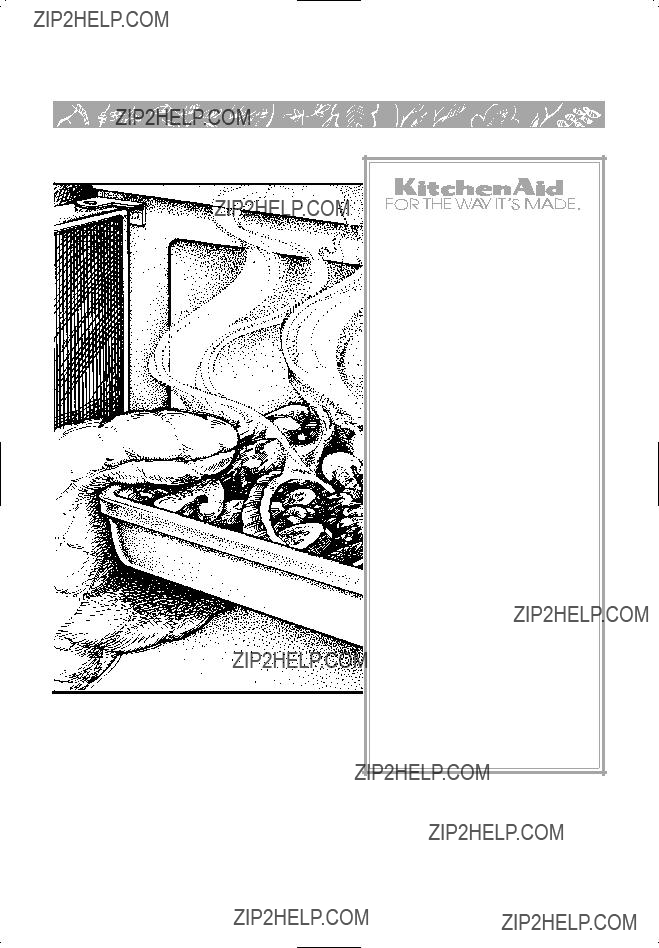
Use and Care Guide
For assistance or service, call the
Consumer Assistance Centre:
KITCHENAID??
Combination
Model: YKHMC107E

Use and Care Guide
For assistance or service, call the
Consumer Assistance Centre:
KITCHENAID??
Combination
Model: YKHMC107E

A Note to You
Thank you for buying a KITCHENAID?? appliance!
KitchenAid designs the best tools for the most important room in your house. To ensure that you enjoy many years of
Please record your model???s information.
Whenever you call our Consumer Assistance Centre at
Please also record the purchase information.
NOTE: You must provide proof of purchase or installation date for
Model Number________________________________
Serial Number__________________________
Purchase/
Installation Date ________________________
Builder/Dealer
Name __________________________________
Address ________________________________
Phone__________________________________
Keep this book and the sales slip together in a safe place for future reference.
2
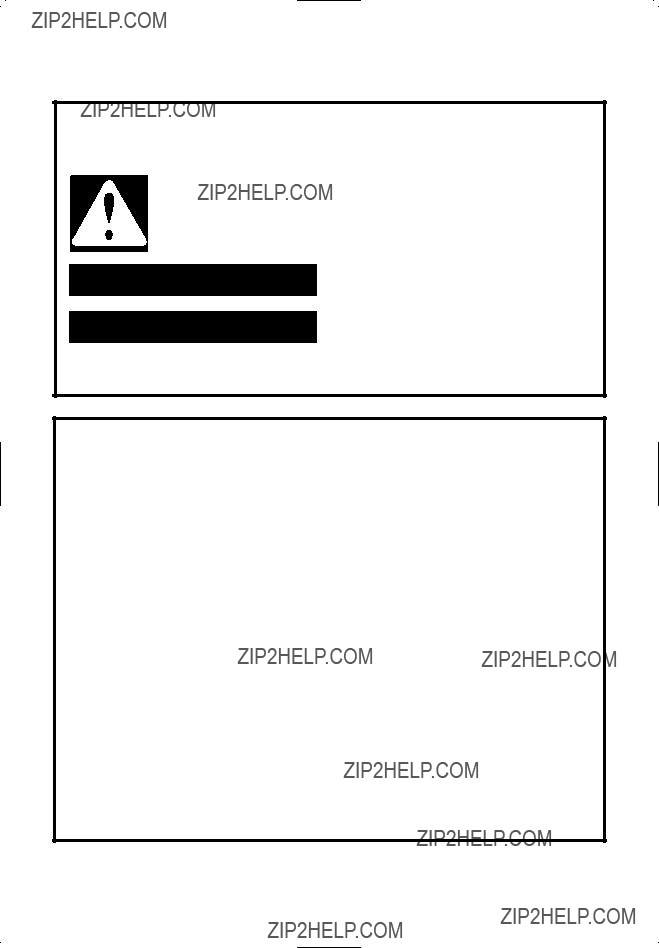
Microwave Oven Safety
Your safety and the safety of others is very important.
We have provided many important safety messages in this manual and on your appliance. Always read and obey all safety messages.
This is the safety alert symbol.
This symbol alerts you to hazards that can kill or hurt you and others.
All safety messages will be preceded by the safety alert symbol and the word ???DANGER??? or ???WARNING.??? These words mean:
wDANGER
wWARNING
You will be killed or seriously injured if you don???t follow instructions.
You can be killed or seriously injured if you don???t follow instructions.
All safety messages will identify the hazard, tell you how to reduce the chance of injury, and tell you what can happen if the instructions are not followed.
IMPORTANT SAFETY INSTRUCTIONS
When using electrical appliances basic safety precautions should be followed, including the following:
WARNING: To reduce the risk of burns, electric shock, fire, injury to persons, or exposure to excessive microwave energy:
???Read all instructions before using the microwave oven.
???Read and follow the specific ???PRE-
CAUTIONS TO AVOID POSSIBLE
EXPOSURE TO EXCESSIVE MICROWAVE ENERGY??? found in this section.
???The microwave oven must be grounded. Connect only to properly grounded outlet. See ???GROUNDING INSTRUCTIONS??? found in the ???Installation Instructions??? section and on page 5 of this manual.
???Install or locate the microwave oven only in accordance with the provided Installation Instructions.
???Some products such as whole eggs in the shell and sealed containers ??? for example, closed glass jars ??? may explode and should not be heated in the microwave oven.
???Use the microwave oven only for its intended use as described in this manual. Do not use corrosive chemicals or vapors in the microwave oven. This type of oven is specifically designed to heat, cook, or dry food. It is not designed for industrial or laboratory use.
???As with any appliance, close supervision is necessary when used by children.
???Do not operate the microwave oven if it has a damaged cord or plug, if it is not working properly, or if it has been damaged or dropped.
??? SAVE THESE INSTRUCTIONS ???
continued on next page
3
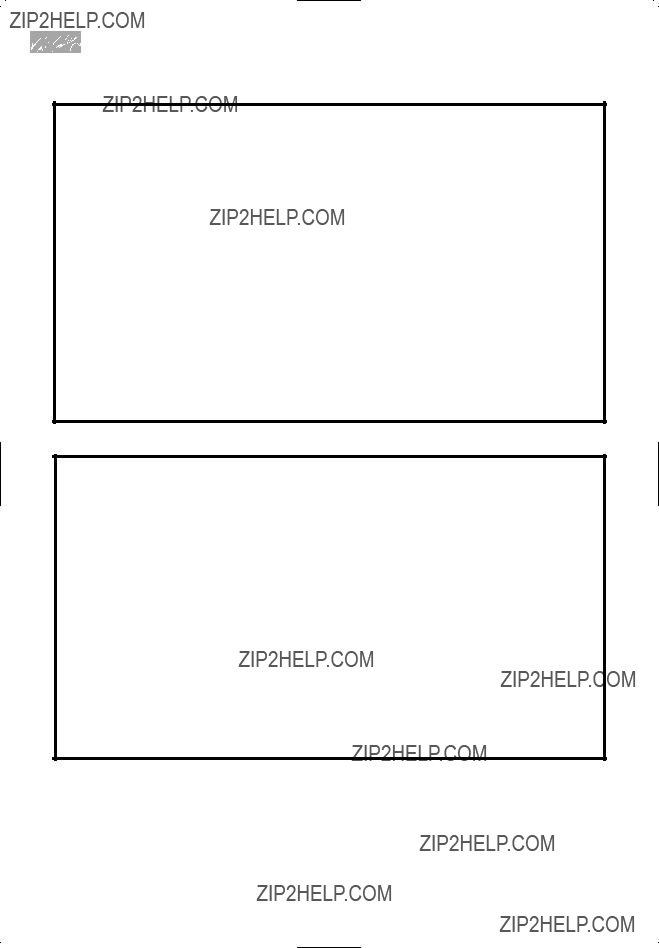
Microwave Oven Safety
IMPORTANT SAFETY INSTRUCTIONS
???The microwave oven should be serviced only by qualified service personnel.
Call an authorized service company for examination, repair, or adjustment.
???See door surface cleaning instructions in the ???Caring for Your Microwave Oven??? section.
???To reduce the risk of fire in the oven cavity:
???Do not overcook food. Carefully attend the microwave oven if paper, plastic, or other combustible materials are placed inside the oven to facilitate cooking.
???Remove wire
???If materials inside the oven should ignite, keep oven door closed, turn oven off, and disconnect the power cord, or shut off power at the fuse or circuit breaker panel.
???Do not use the cavity for storage purposes. Do not leave paper products, cooking utensils, or food in the cavity when not in use.
??? SAVE THESE INSTRUCTIONS ???
PRECAUTIONS TO AVOID POSSIBLE
EXPOSURE TO EXCESSIVE MICROWAVE ENERGY...
(a)Do not attempt to operate this oven with the door open since
(b)Do not place any object between the oven front face and the door or allow soil or cleaner residue to accumulate on sealing surfaces.
(c)Do not operate the oven if it is damaged. It is particularly important that the oven door close properly and that there is no damage to the:
(1)Door (bent),
(2)Hinges and latches (broken or loosened),
(3)Door seals and sealing surfaces.
(d)The oven should not be adjusted or repaired by anyone except properly qualified service personnel.
4
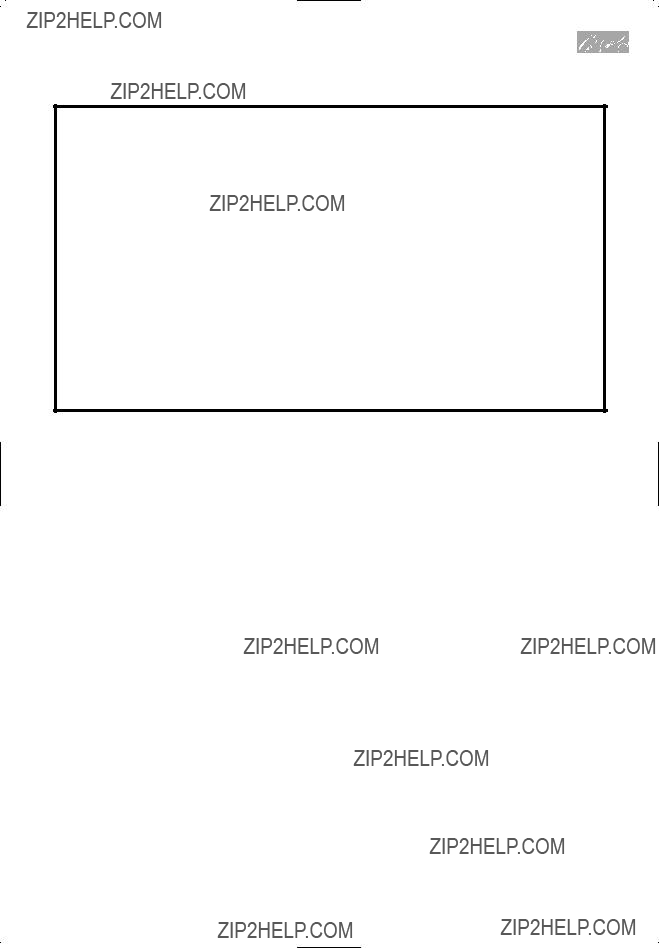
Microwave Oven Safety
GROUNDING INSTRUCTIONS
For all cord connected appliances:
The microwave oven must be grounded. In the event of an electrical short circuit, grounding reduces the risk of electric shock by providing an escape wire for the electric current. The microwave oven is equipped with a cord having a ground- ing wire with a grounding plug. The plug must be plugged into an outlet that is properly installed and grounded.
WARNING: Improper use of the grounding can result in a risk of electric shock.
Consult a qualified electrician or service- man if the grounding instructions are not
completely understood, or if doubt exists as to whether the microwave oven is properly grounded.
Do not use an extension cord. If the power supply cord is too short, have a qualified electrician or serviceman install an outlet near the microwave oven.
For a permanently connected appliance: This appliance must be connected to
a grounded, metallic, permanent wiring system, or an equipment grounding conductor should be run with the circuit conductors and connected to the equip- ment grounding terminal or lead on the appliance.
5
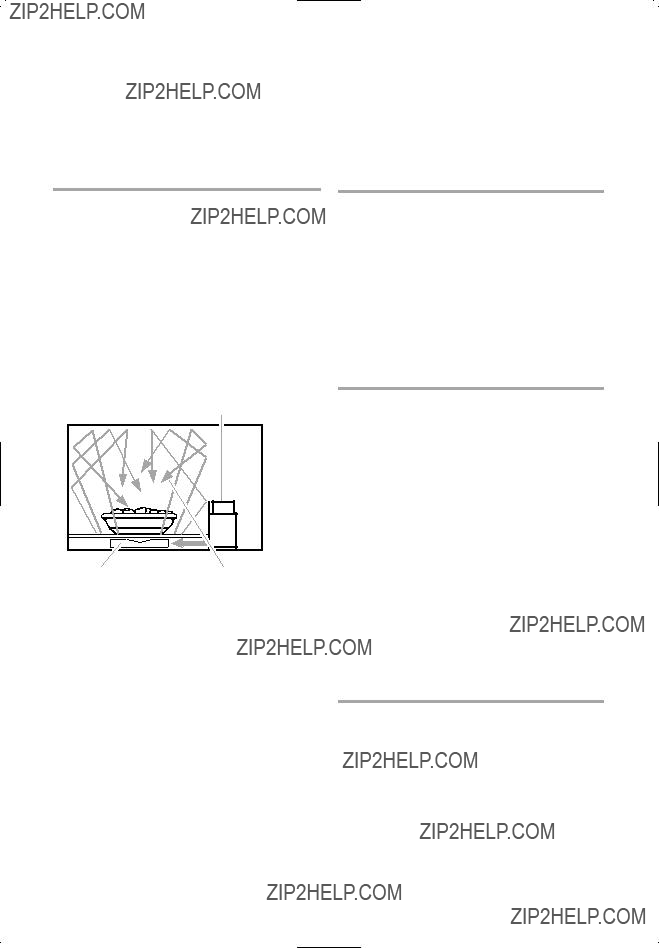
Getting to Know Your Microwave- Convection Hood Combination
This section discusses the concepts behind microwave cooking. It also shows you the basics you need to know to operate your microwave oven. Please read this information before you use your oven.
How your microwave oven works
Microwave ovens are safe. Microwave energy is not hot. It causes food to make its own heat, and it's this heat that cooks the food.
Microwaves are like TV waves, radio waves or light waves. You cannot see them, but you can see what they do.
A magnetron in the microwave oven produces microwaves. The microwaves move into the oven where they contact food as it turns on the turntable.
Radio interference
Using your microwave oven may cause interference to your radio, TV, or similar equipment. When there is interference, you can reduce it or remove it by:
???Cleaning the door and sealing surfaces of the oven.
???Adjusting the receiving antenna of the radio or television.
???Moving the receiver away from the microwave oven.
Microwaves pass through most glass, paper, and plastics without heating them so food absorbs the energy. Microwaves bounce off metal containers so food does not absorb the energy.
The microwaves disturb water molecules in the food. As the molecules bounce around bumping into each other, heat is made, like rubbing your hands together. This is the heat that does the cooking.
For the best cooking results
???Always cook food for the shortest cooking time recommended. Check to see how the food is cooking. If needed, touch the EASY MINUTE while the oven is operating or after the cooking cycle is over (see the ???Using EASY MINUTE??? section).
???Stir, turn over, or rearrange the food being cooked about halfway through the cooking time for all recipes. This will help make sure the food is evenly cooked.
NOTE: Some cycles may have to be reset if you have interrupted the cycle.
???If you do not have a cover for a dish, use wax paper, or
Testing your microwave oven
To test the oven put about 1 cup (250 mL) of cold water in a glass container in the oven. Close the door. Make sure it latches. Cook at 100% power for 2 minutes. When the time is up, the water should be heated.
6

Getting to know your
Testing your dinner- ware or cookware
Test dinnerware or cookware before using. To test a dish for safe use, put it into the oven with a cup of water beside it. Cook at 100% cook power for one minute. If the dish gets hot and water stays cool, do not use it. Some dishes (melamine, some ceramic dinnerware, etc.) absorb microwave energy, becoming too hot to handle and slowing cooking times. Cooking in metal containers not designed for microwave use could damage the oven, as could containers with hidden metal
Operating safety precautions
???Never lean on the door or allow a child to swing on it when the door is open.
???Use hot pads. Microwave energy does not heat containers, but heat from the food can make the container hot.
???Do not use newspaper or other printed paper in the oven.
???Do not dry flowers, fruit, herbs, wood, paper, gourds, or clothes in the oven.
???Do not start a microwave oven when it is empty. Product life may be shortened. If you practice programming the oven, put a container of water in the oven. It is normal for the oven door to look wavy after the oven has been running for a while.
???Do not try to melt paraffin wax in the oven. Paraffin wax will not melt in a microwave oven because it allows microwaves to pass through it.
???When you use a browning dish, follow the directions supplied with the browning dish.
???Never cook or reheat a whole egg inside the shell. Steam buildup in whole eggs may cause them to burst, and possibly damage the oven. Slice
???For best results, stir any liquid several times during heating or reheating.
Liquids heated in certain containers (especially containers shaped like cylinders) may become overheated. The liquid may splash out with a loud noise during or after heating or when adding ingredients (coffee granules, tea bags, etc.). This can harm the oven.
???Microwaves may not reach the center of a roast. The heat spreads to the center from the outer, cooked areas just as in regular oven cooking. This is one of the reasons for letting some foods (for example, roasts or baked potatoes) stand for a while after cooking, or for stirring some foods during the cooking time.
???Do not deep fry in the oven. Microwavable cookware is not suitable and it is difficult to maintain appropriate deep frying temperatures.
???Do not overcook potatoes. At the end of the recommended cooking time, potatoes should be slightly firm because they will continue cooking during standing time.
After microwaving, let potatoes stand for 5 minutes. They will finish cooking while standing.
Electrical connection
If the incoming voltage to the microwave is less than 110 volts, cooking times may be longer. Have a qualified electrician check your electrical system.
7
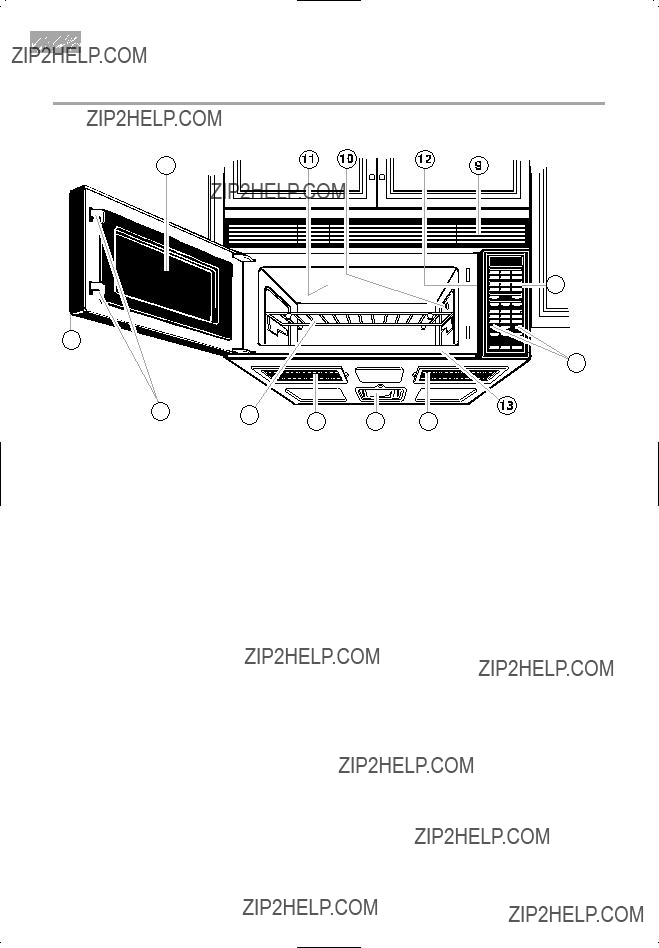
Getting to know your
Microwave oven features
1
8
7
Your microwave oven is designed to make your cooking experience as enjoyable and productive as possible. To get you up and running quickly, the following is a list of the oven???s basic features:
1.Door Handle. Pull to open door.
2.Door Safety Lock System. The oven will not operate unless the door is securely closed.
3.Window with Metal Shield. Shield pre- vents microwaves from escaping. It is de- signed as a screen to allow you to view food as it cooks.
4.
5.Filters. See page 60 for cleaning information.
6.Cooktop/Countertop Light. Turn on to light your cooktop or countertop or turn on as a night light. See page 13 for more information.
7.Exhaust Fan and Cooktop/Countertop Light Switches. See pages
65
8.Control Panel. Touch the pads on this panel to perform all functions. See pages
9.Vent Grille.
10.Temperature Probe Socket (on oven wall). Plug the Temperature Probe into this socket when using probe for cook- ing. See pages
NOTE: Do not store the Temperature Probe in the oven when probe is not being used. Store in a handy place.
11.Convection Air Openings (on upper oven cavity). See page 40 for informa- tion on convection cooking.
12.Model and Serial Number Plate.
13.Cooking Guide Label.
8
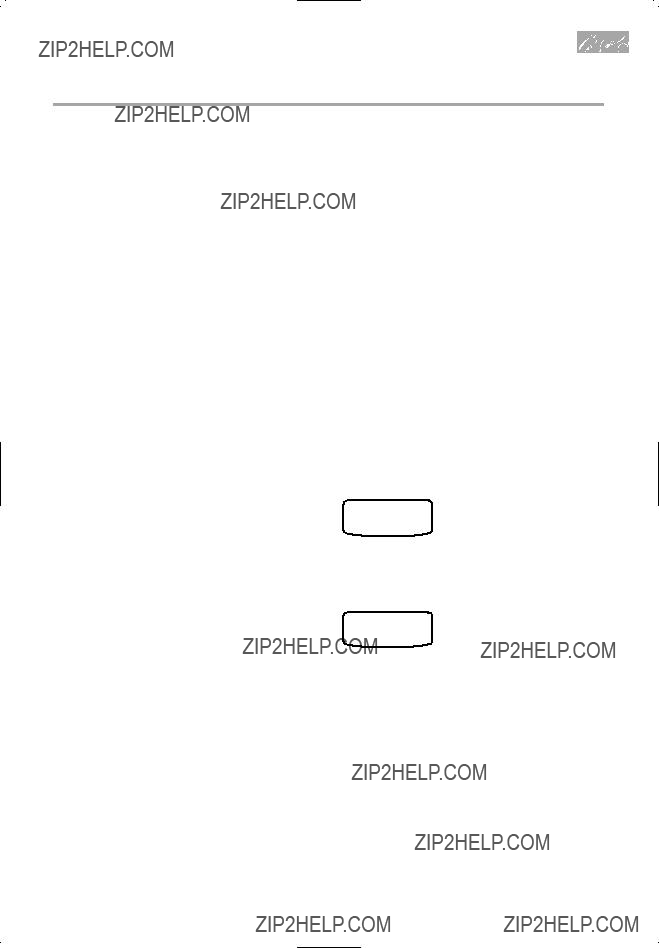
Getting to know your
Control panel features
Your microwave oven control panel lets you select the desired cooking function quickly and easily. All you have to do is touch the necessary Command Pad. Below are descriptions of some basic functions you should know about. These descriptions are followed, on the next page, by a list of all the Command and Number Pads located on the control panel. For more information, see pages
Using the demonstration feature
You can set your microwave oven to dem- onstrate its functions without turning the oven on.
NOTE: This feature can only be used when the microwave oven is first connected to power. You cannot use the demonstration feature after a Command Pad has been touched.
To set the demo feature:
1.Open the door and keep it open.
2.Touch and hold DELAY START for 4 seconds. Three tones, followed by two tones, will sound.
3.Release DELAY START.
4.Shut the door to start the demo.
To cancel the demo feature:
Touch CANCEL/OFF.
Audible signals
Audible signals are available to guide you when setting and using your oven:
???A programming tone will sound each time you touch a pad.
???One long tone signals the end of a Minute Timer countdown.
???Four tones signal the end of a cooking cycle.
???Two tones sound once every minute after an
???Three tones sound if you have made an incorrect entry.
To disable audible signals:
???Touch and hold Number Pad 1 for
4 seconds to disable programming tones.
OR
???Touch and hold Number Pad 2 for 4 seconds to disable all signals.
To turn signals back on:
Repeat steps under ???To disable audible signals??? above.
NOTE: Three tones, followed by two tones, will sound when audible signals are turned on or off. The three tones will be omitted if all tones are disabled.
Interrupting cooking
You can stop the oven during a cycle by opening the door.
The oven stops heating and the fan stops, but the light stays on. To restart cooking, close the door and
TOUCH
START
If you do not want to continue cooking:
???Close the door and the light goes off.
OR
???TOUCH
CANCEL
OFF
Using the safety lock
The safety lock prevents unwanted use of the microwave oven by disabling the control panel Command Pads.
To lock or deactivate the control panel:
Touch and hold Number Pad 3 for 4 seconds. Three tones, followed by
two tones, will sound and  will appear on the Display.
will appear on the Display.
To cancel the safety lock:
Touch and hold Number Pad 3 for
4 seconds. Two tones will sound and  will be cleared from the Display.
will be cleared from the Display.
9
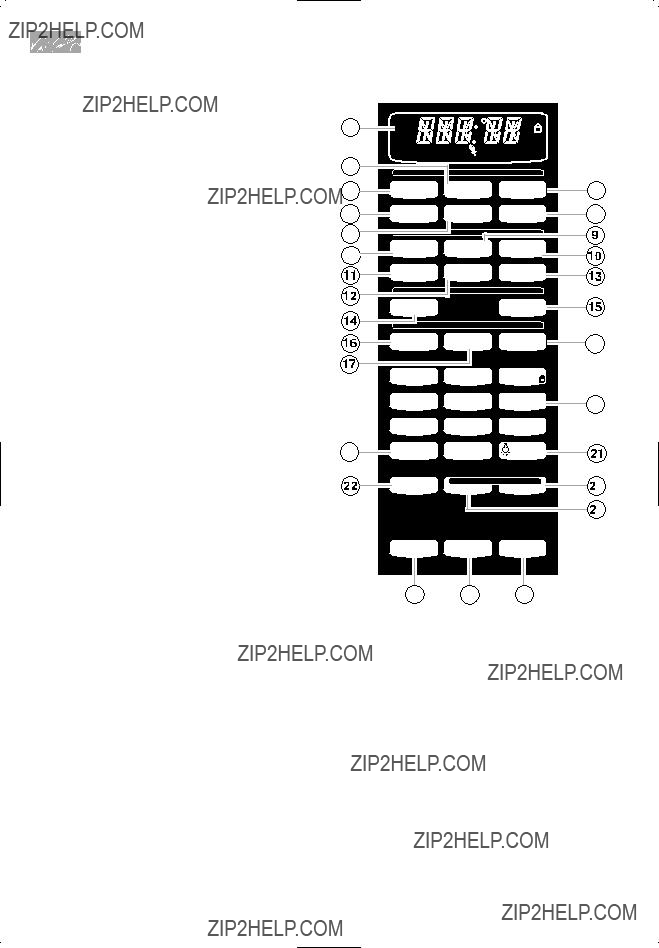
Getting to know your
1.Display. The Display includes a clock and indicators to tell you time of day, cooking time settings, and cooking functions selected.
2.MICRO COOK. Touch this pad followed by Number Pads to set a cooking time. See pages 19, 21, 22 for more informa- tion.
3.COOK POWER. Touch this pad after the cook time has been set, followed by a Number Pad to set the amount of micro- wave energy released to cook the food. The higher the number, the higher the microwave power or ???cooking speed.??? See page 20 for more information. See the ???Microwave cooking chart??? on page 64 for specific Cook Powers to use for the foods you are cooking.
4.EASY MINUTE. Touch this pad to cook for 1 minute, at 100% Cook Power, or to add an extra minute, at the set Cook Power, to your cooking cycle. See page 39 for more information.
5.CUSTOM DEFROST. Touch this pad fol- lowed by Number Pads to thaw frozen meat by weight. See page 23 for more information.
6.TEMP PROBE. Touch this pad when using the Temperature Probe to cook. Touch TEMP PROBE followed by Number Pads to set desired final food tempera- ture. See page 29 for more information.
7.KEEP WARM. Touch this pad to keep hot, cooked foods safely warm in your microwave oven for up to 99 minutes,
99 seconds. KEEP WARM can be used by itself, or it can automatically follow a cooking cycle. See page 28 for more information.
8.AUTO COOK. Touch this pad to cook at a preset Cook Power. The oven???s sensor will tell the oven how long to cook de- pending on the amount of vapor it detects from the food. See page 35 for more information.
 5
5  6
6  7
7
9.SLOWCOOK/SIMMER. Touch this pad to stew or simmer food. The oven???s sensor will tell the oven how long to cook depending on the amount of vapor it detects from the food. See page 38 for more information.
10.AUTO ROAST. Touch this pad to roast with the Temperature Probe. See page 32 for more information.
11.POPCORN. Touch this pad to pop popcorn at a preset Cook Power. See page 37 for more information.
10

Getting to know your
12.BEVERAGE. Touch this pad to reheat a cup of a beverage at a preset Cook Power. See page 36 for more information.
13.BAKED POTATO. Touch this pad to bake a potato at a preset Cook Power. The oven???s sensor will tell the oven how long to heat depending on the amount of vapor it detects from the potato. See page 38 for more information.
14.CONVECTION BAKE. Touch this pad to bake with convection heat. See pages 40- 44 and pages
15.CONVECTION BROIL. Touch this pad to broil with convection heat. See pages 40 and
16.COMBINATION BAKE. Touch this pad to bake with both convection heat and mi- crowaves. See pages
17.AUTO COMBI. Touch this pad to cook with both convection heat and micro- waves at preset times and Cook Powers. See pages
18.COMBINATION ROAST. Touch this pad to roast with both convection heat and microwaves. See pages
19.Number Pads. Touch Number Pads to enter cooking times, Cook Powers, temperatures, weights, or food categories.
20.FAN. Touch this pad once to turn on the fan at high speed, twice to turn on the fan at low speed, and three times to turn the fan off. See page 12 for more information.
21.LIGHT. Touch this pad once to turn the cooktop/countertop light on at high power, twice to turn the cooktop/countertop light on at low power as a night light, and three times to turn the cooktop/countertop light off. See pages
22.CLOCK SET ??? START. Touch this pad to enter the correct time of day. See page 16 for more information.
23.TIMER SET ??? START. Touch this pad to set the Minute Timer. See page 17 for more information.
24.TIMER CANCEL. Touch this pad to cancel the Minute Timer. See page 17 for more information.
25.START. Touch this pad to start a function. If you open the door after the oven begins to cook, retouch START. See page 9 for more information.
26.DELAY START. Touch this pad to program your oven to begin cooking automatically at a chosen time later in the day. See page 34 for more information.
27.CANCEL/OFF. Touch this pad to erase an incorrect command, cancel a program during cooking, or to clear the Display. See page 9 for more information.
11
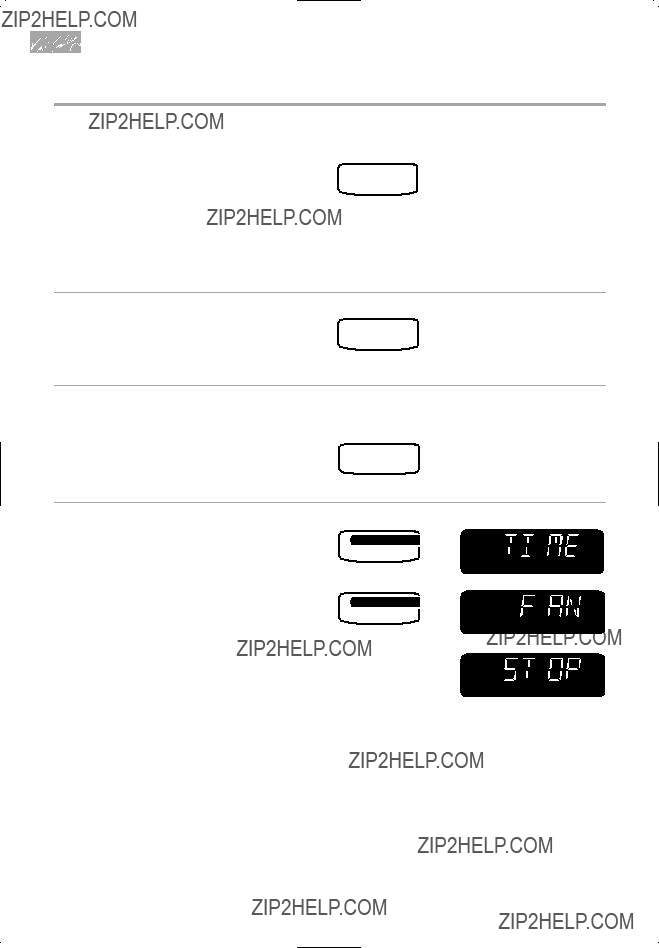
Getting to know your
Using the exhaust fan
1. Choose fan speed.
NOTE: If the temperature gets too hot around the microwave oven, the exhaust fan in the vent hood will automatically turn on at the LOW setting to protect the oven. It may stay on up to an hour to cool the oven. When this occurs, the Fan Pad will not turn the fan off.
TOUCH
FAN
HIGH???LOW???OFF
(once for high, twice for low)
(once for high, twice for low)
2. Choose timer.
NOTE: If both the fan and light are operating and the TIMER SET ??? START Pad is touched twice, both the fan and light will be controlled by the timer. The Display will alternate between ???FAN??? and ???LIGHT??? one time before ???STOP??? is displayed.
12
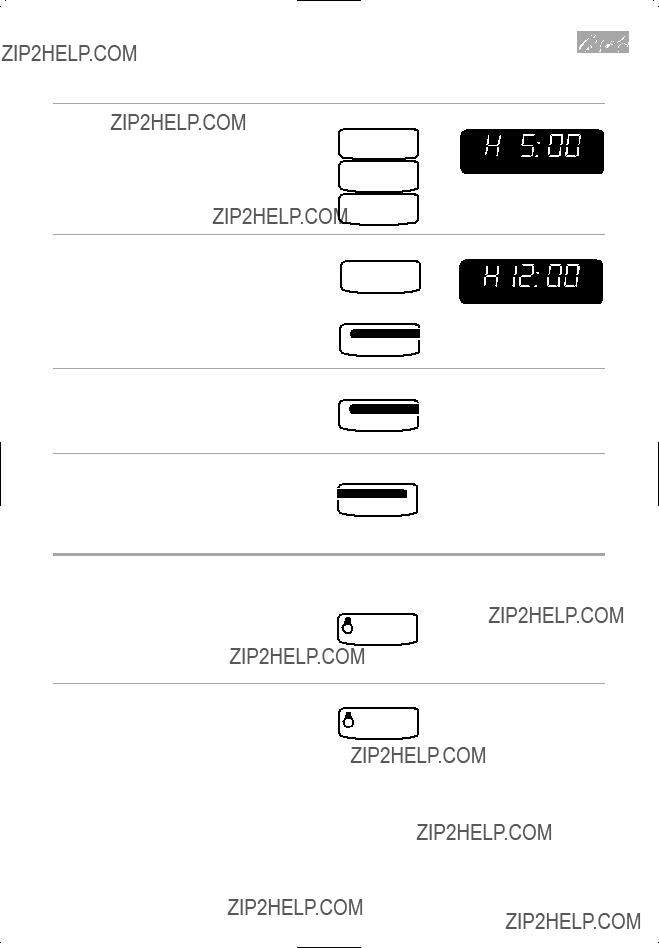
Getting to know your
to the next 12 hours.
0
4. Start timer.
To check the stop time:
The set time will be displayed for 3 seconds.
TOUCH
TIMER
SET???START
To cancel timer:
NOTE: Canceling the timer will cause the fan to shut off; however, canceling the fan will not cancel the timer.
TOUCH
TIMER
CANCEL
Using the cooktop/countertop light
1. Turn on light.
TOUCH
LIGHT
 ON???NIGHT???OFF
ON???NIGHT???OFF
(once for high, twice for low)
2. Turn off light when desired.
TOUCH
LIGHT
 ON???NIGHT???OFF
ON???NIGHT???OFF
(three times)
13

Getting to know your
To set light to be on for a specific time:
1. Turn on light.
TOUCH
LIGHT
 ON???NIGHT???OFF
ON???NIGHT???OFF
(once for high, twice for low)
2. Choose timer.
NOTE: If both the fan and light are operating and the TIMER SET ??? START Pad is touched twice, both the fan and light will be controlled by the timer. The Display will alternate between ???FAN??? and ???LIGHT??? one time before ???STOP??? is displayed.
seconds)
next 12 hours.
0
4. Start timer.
OR
To cancel timer:
NOTE: Canceling the timer will cause the light to shut off; however, canceling the light will not cancel the timer.
TOUCH
TIMER
CANCEL
14
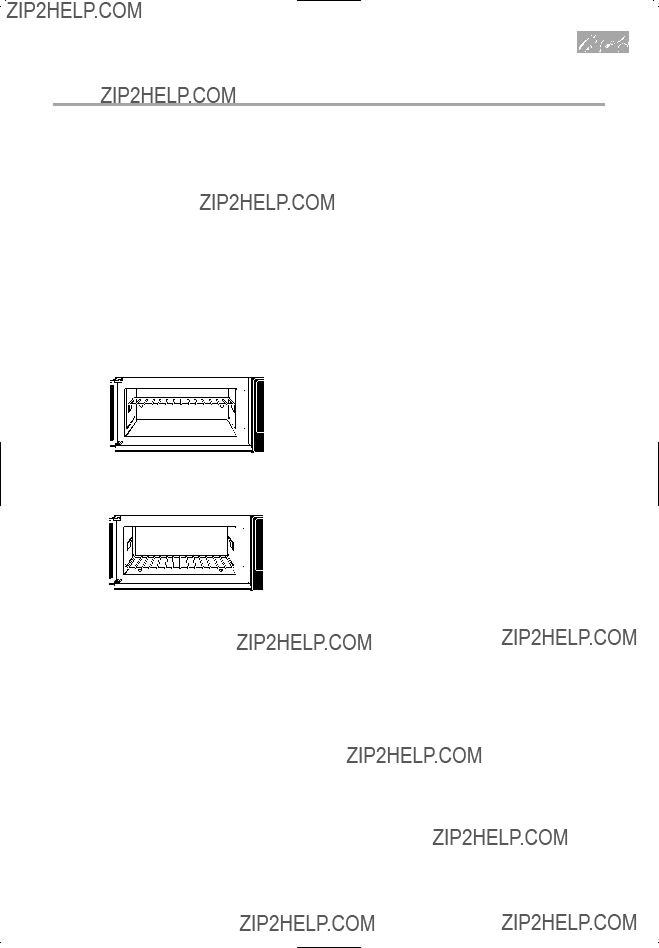
Getting to know your
Using the metal rack
The Metal Rack (Part No. 4359242) gives you extra space when cooking in more than one container at the same time. The metal rack must not be turned
If you need a replacement rack and your KitchenAid dealer does not stock the rack, you can order it, by part number, by calling
Inserting the rack
Normal position: Insert the rack securely on the rack guides on the side walls of the oven.
Bottom position: Insert the rack securely on the bottom of the oven.
Notes:
???Do not store the Metal Rack in the oven. Arcing and damage to the oven could result if someone accidentally starts the oven.
???Use rack only in the microwave oven.
???Do not use rack with browning dish.
???Do not let food container on rack touch the top or sides of the oven.
???For microwave cooking, do not cook foods directly on rack without putting them in containers first.
???When convection or combination cook- ing, you may be able to cook some foods directly on the rack. (See ???Convection Cooking??? and ???Combination Cooking??? sections for additional information.)
???Do not place a metal cooking container on rack when microwave cooking or combination cooking. Place a microwave- safe plate under container.
???Only use the Metal Rack when cooking at more than one level.
15
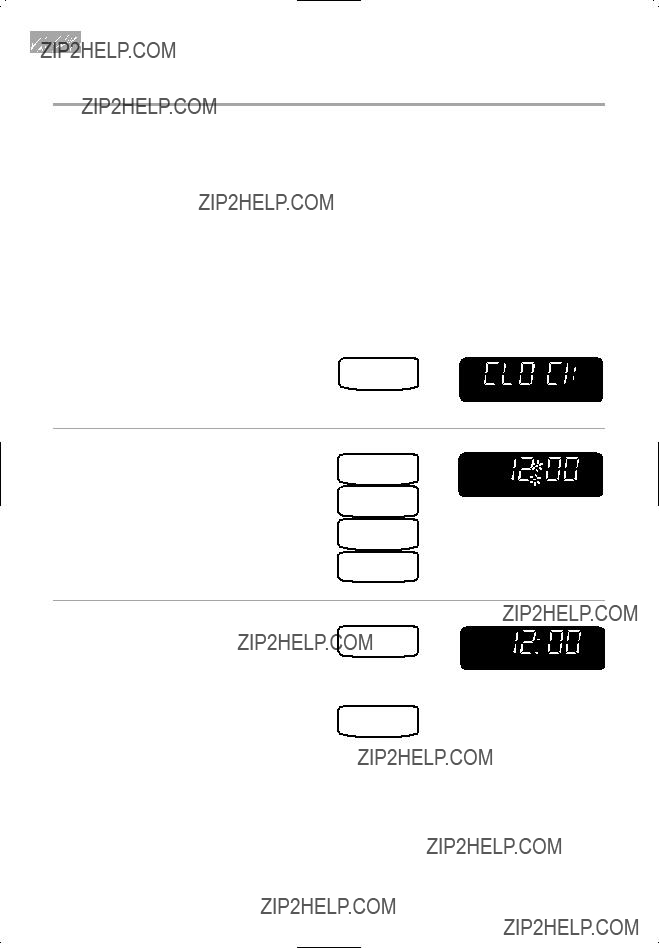
Getting to know your
Setting the clock
When your microwave oven is first plugged in or after a power failure, the Display will show ???888:88???. For the first 30 seconds after the power is on, you can set the clock time without touching CLOCK SET ??? START. After 30 seconds have gone by, you must follow the directions below to set the time. If a time of day is not set, ???888:88??? will show in the Display until you touch CLOCK SET ??? START.
NOTES:
???You can only set the clock if the oven is not cooking food.
???If you touch in an incorrect time and touch CLOCK SET ??? START, three tones will sound. Enter the correct time.
???If you touch CANCEL/OFF while setting the clock, the Display will show the last time of day set or ???:??? if no time of day has been set.
To set time:
1. Choose setting.
(for 3 seconds)
0
0
3. Complete entry.
OR
START
16
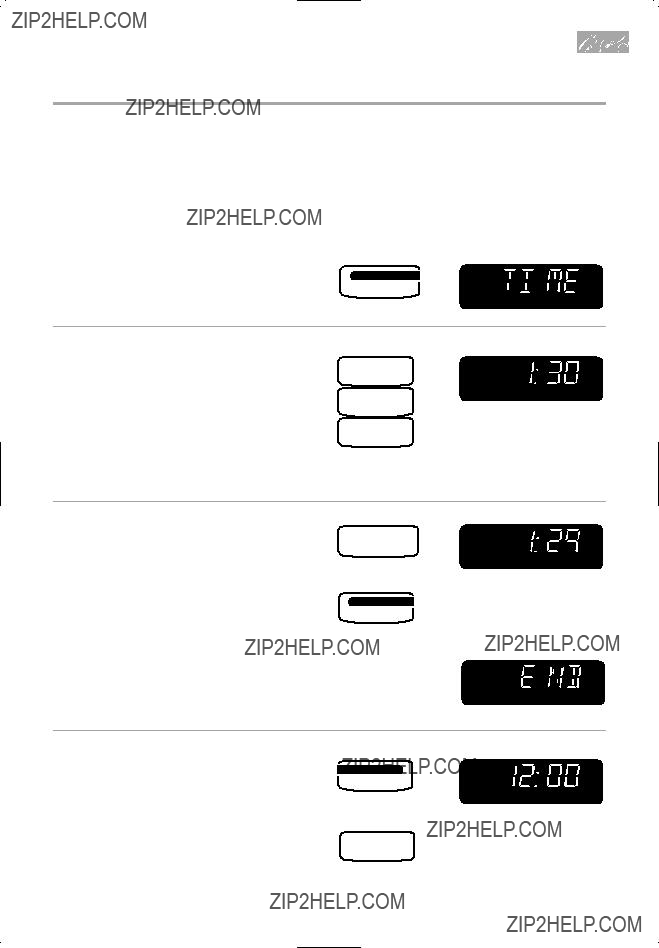
Getting to know your
Using the Minute Timer
You can use your microwave oven as a minute timer. Use the Minute Timer for timing up to 99 minutes, 99 seconds.
NOTE: The oven can operate while the Minute Timer is in use. To see the Minute Timer while the oven is cooking, touch TIMER SET ??? START. The Display will return to the cooking time countdown after 3 seconds.
1. Touch TIMER SET ??? START.
2. Enter time to be counted down.
Example for 1 minute, 30 seconds:
NOTE: If you enter more than 4 digits, three tones will sound. Touch START to count down the
0
3. Start countdown.
NOTE: If you do not do this step within
3 seconds of doing Step 2, ???START???? will be displayed. You then have 1 minute to touch START or TIMER SET ??? START before the Display returns to time of day.
OR
TIMER
SET???START
(one tone will sound)
(time of day)
17

Microwave Cooking
This section gives you instructions for operating each function. Please read these instruc- tions carefully.
Getting the best cooking results
???ALWAYS cook food for the minimum recommended cooking time. If necessary, touch EASY MINUTE while the oven is operating or after it has completed the cooking cycle (see page 39 for more information). Then check for doneness to avoid overcooking the food.
???Stir, turn over, or rearrange food being cooked about halfway through the cook time for most even doneness with all recipes.
???If a glass cover is not available, use wax paper, paper towels, or microwave- approved plastic wrap. Turn back a corner to vent steam during cooking.
???Although a new rating method* rates this oven at 850 watts, you may use a reliable cookbook and recipes developed for microwave ovens previously rated at
18
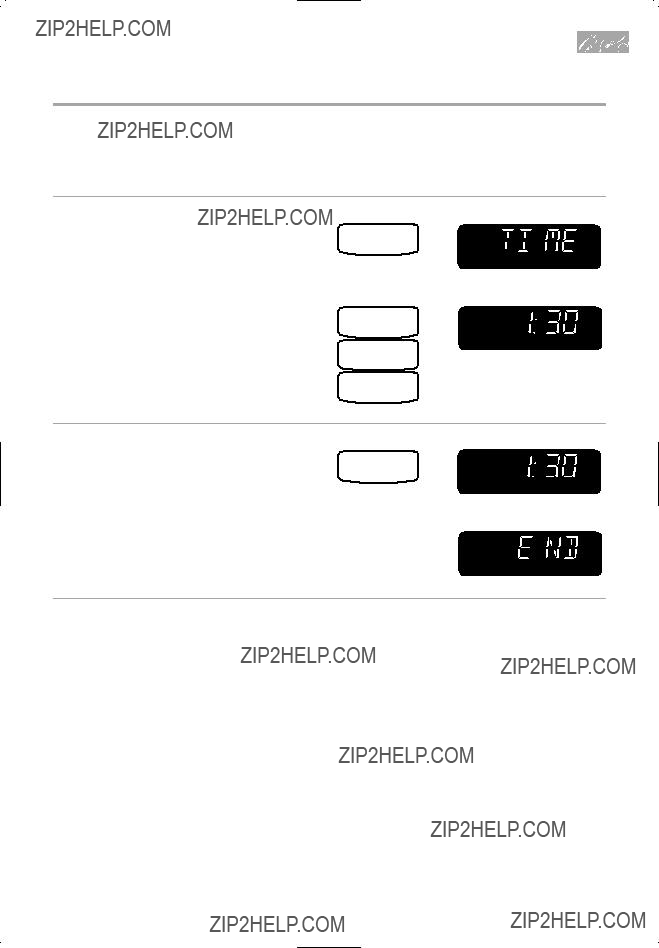
Microwave cooking
Cooking at high cook power
1.Put food in oven and close the door.
2. Set cooking time.
0
3. Start oven.
Changing instructions
You can change the cooking time after cooking starts by repeating Steps 2 and 3.
19

Microwave cooking
Cooking at different cook powers
For best results, some recipes call for differ- ent cook powers. The lower the cook power, the slower the cooking. Each Number pad also stands for a different percentage of cook power. Many microwave cookbook recipes tell you by number, percent, or name which cook power to use.
The following chart gives the percentage of cook power each Number pad stands for, and the cook power name usually used. It also tells you when to use each cook power. Follow recipe or food package instructions if available.
NOTE: Once cook time has been entered you can also use the cook power pad as a second Minute Timer by entering ???0??? for the cook power. The oven will count down the cooking time you set without cooking.
20
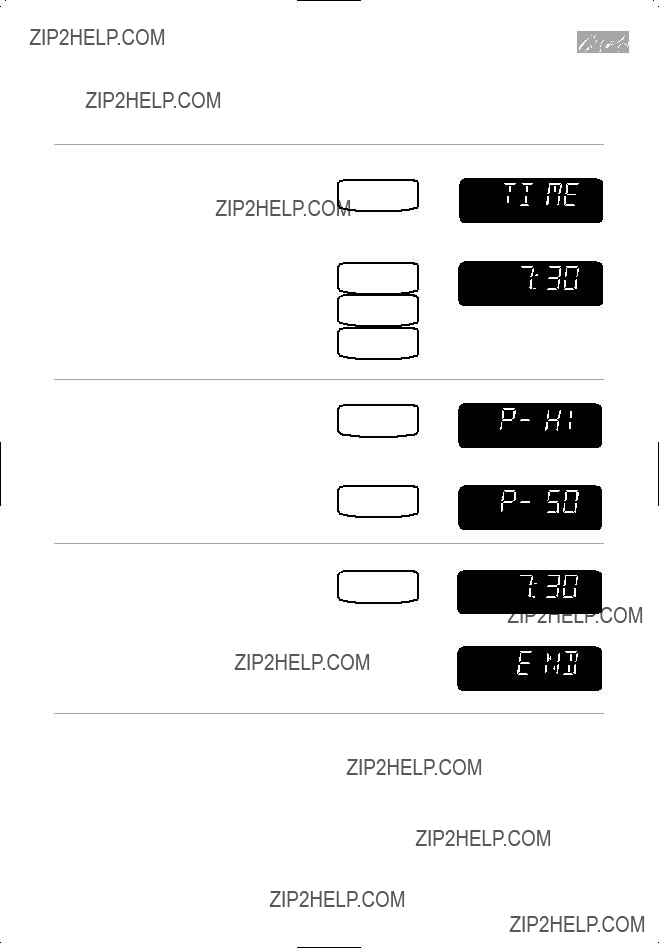
Microwave cooking
MICRO
COOK
0
3. Set Cook Power.
4. Start oven.
Changing instructions
You can change the cooking time or Cook
Power after cooking starts by repeating
Steps 2 and/or 3 and 4.
21
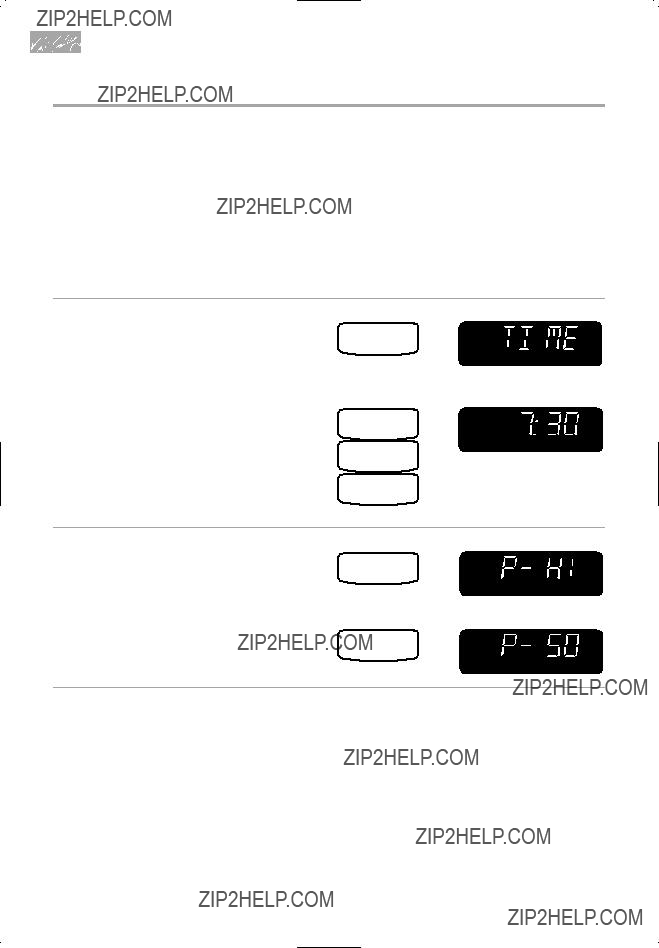
Microwave cooking
Cooking with more than one cook cycle
For best results, some recipes call for one Cook Power for a certain length of time, and another Cook Power for another length of time. Your oven can be set to change from one to another automatically, for up to two cycles.
1.Put food in oven and close the door.
MICRO
COOK
0
COOK
POWER
4.Repeat Steps 2 and 3 to set cooking time and Cook Power for the second cycle.
22
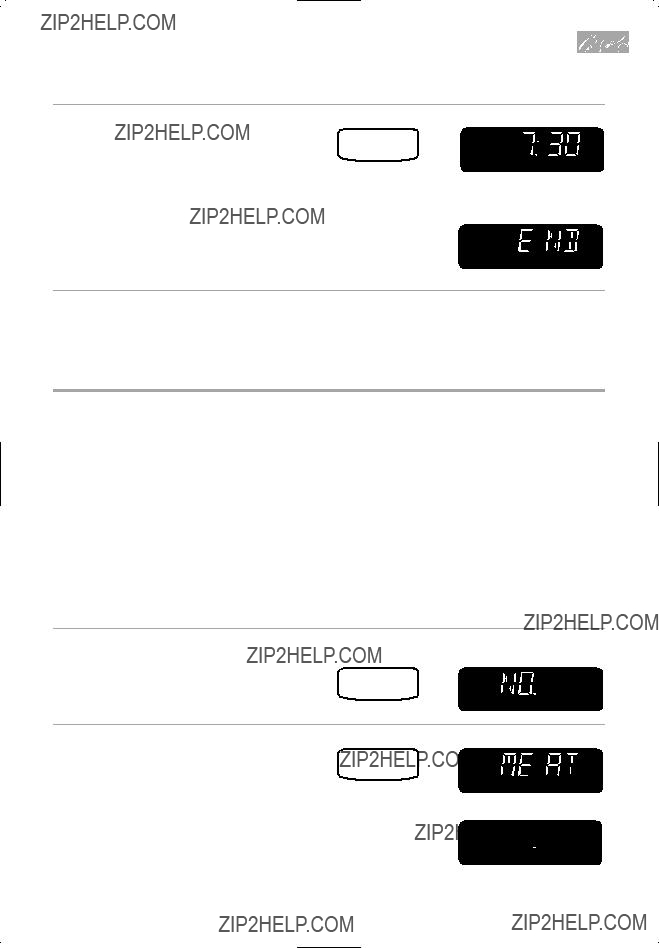
Microwave cooking
5. Start oven.
After the first cycle is over, the next cycle will count down.
At end of cooking time:
(first cycle)
YOU SEE
Changing instructions
You can change times or Cook Powers for a cycle any time after that cycle starts by repeating Steps 2 and/or 3 and 4.
Using CUSTOM DEFROST
Your microwave oven automatically defrosts a variety of foods at preset Cook Powers for preset times. The
NOTES:
???Remove wrapping or covering from food before defrosting. See the ???Custom defrost chart??? on pages 25 and 26 for defrosting directions for each food.
???To defrost items not listed in ???Custom defrost chart??? on pages 25 and 26, use 30% Cook Power. Refer to a reliable cookbook for defrosting information.
1.Put frozen food in oven and close the door.
???You can set CUSTOM DEFROST as one of your steps in
2. Choose CUSTOM DEFROST.
CUSTOM
DEFROST
continued on next page
23

Microwave cooking
4. Enter food???s weight (in pounds and tenths of a pound).
Example for 1.2 lbs (.54 kg):
NOTES:
???For converting fractions of a pound to decimals, see ???Weight conversion chart??? on page 27.
???If you enter an incorrect weight, touch CUSTOM DEFROST again and enter the correct weight.
5. Start oven.
6.After half the cook time is over, Display will prompt you to turn over food.
Open door, turn over food, and shield any warm portions.
YOU SEE
NOTE: If you do not open the door within 2 minutes, the Display will resume the countdown.
7. Restart oven.
(time remaining)
ENTER
SENSOR
PREHEAT
WEIGHT
AUTO COOK DEFR TEMP
ROAST PWR QTY PROBE
COMB START? TIMER
24
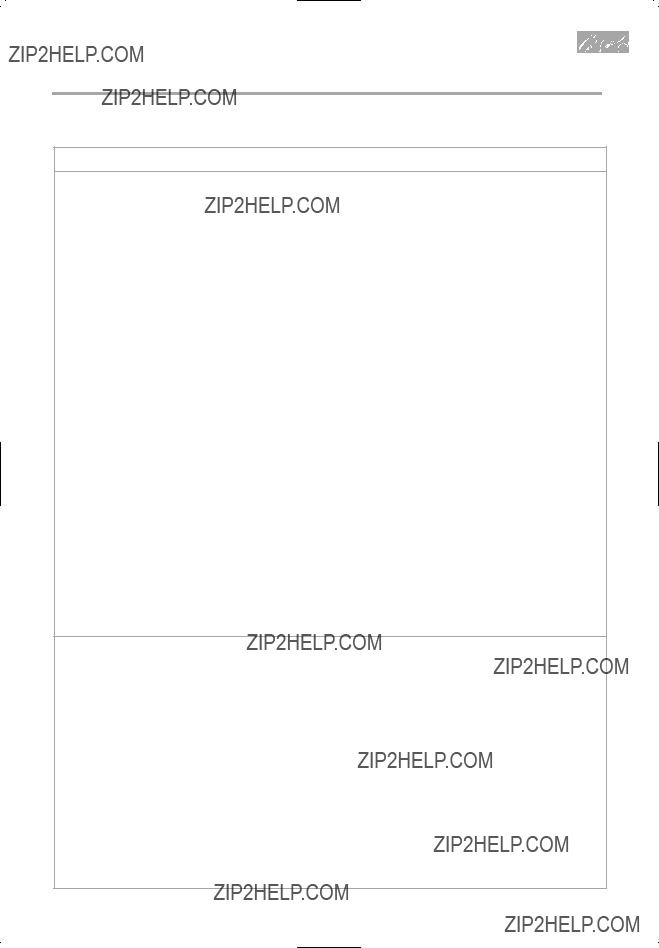
Do not defrost less than 1???4 lb (113 g). Freeze in doughnut shape.
Place on a microwavable roasting rack.
Place in a microwavable baking dish.
Place on a microwavable roasting rack.
Place on a microwavable roasting rack.
Cubes for Stew
Chops
(1 inch [2.5 cm] thick)
Remove thawed portions with fork. Place in a microwavable baking dish. Return remainder to oven.
continued on next page 25

Microwave cooking
Custom defrost chart (continued)
Fish setting
Poultry setting
26

Microwave cooking
Weight conversion chart
You are probably used to food weights as being in pounds and ounces that are fractions of a pound (for example 4 ounces [113 g] equals 1???4 pound). However, in order to enter food weight in CUSTOM DEFROST, you must specify pounds and tenths of a pound.
If the weight on the food package is in fractions of a pound, you can use the following chart to convert the weight to decimals.
Defrosting tips
???When using CUSTOM DEFROST, the weight to be entered is the net weight in pounds and tenths of pounds (the weight of the food minus the container).
???Only use CUSTOM DEFROST for raw food. CUSTOM DEFROST gives best re- sults when food to be thawed is a mini- mum of 0??F
???If the food is kept outside the freezer for up to 20 minutes, enter a lower food weight.
???If the food is kept outside the freezer for more than 20 minutes, and for defrosting
???The shape of the package alters the defrosting time. Shallow rectangular packets defrost more quickly than a deep block.
???Separate pieces as they begin to defrost. Separated pieces defrost more easily.
???You can use small pieces of aluminum foil to shield foods like chicken wings, leg tips, and fish tails, but the foil must not touch the side of the oven. Foil can damage the oven lining.
???Shield areas of food with small pieces of foil if they start to become warm. Make sure the foil does not touch the sides, top, or bottom of the oven.
???For better results, a preset standing time is included in the defrosting time. This may make the defrosting time seem longer than expected. (For more information on stand- ing time, see ???Microwave cooking tips??? on page 64.)
27
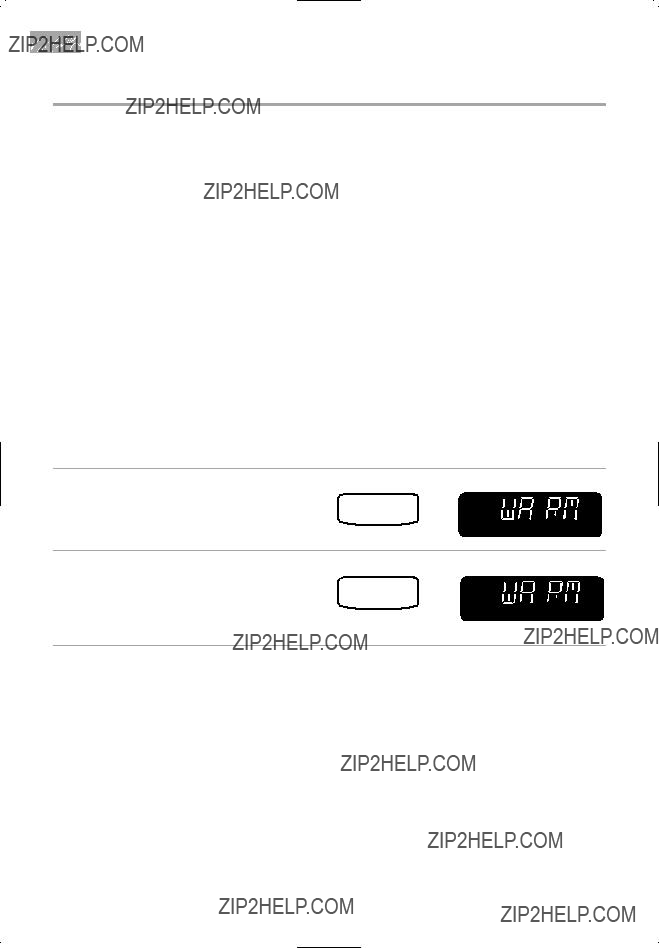
Microwave cooking
Using KEEP WARM
You can safely keep hot, cooked food warm in your microwave oven for up to 99 min- utes, 99 seconds (about 1 hour, 40 min- utes). You can use KEEP WARM by itself, or to automatically follow a cooking cycle.
NOTES:
???KEEP WARM operates for up to 99 minutes, 99 seconds.
???Opening the oven door cancels KEEP WARM. Close the door and touch KEEP WARM, then touch START if additional KEEP WARM time is desired.
???Food cooked covered should be covered during KEEP WARM.
???Pastry items (pies, turnovers, etc.) should be uncovered during KEEP WARM.
1.Put hot, cooked food in oven and close the door.
???Complete meals kept warm on a dinner plate should be covered during KEEP WARM.
???Do not use more than one complete KEEP WARM cycle (about 1 hour, 40
minutes). The quality of some foods will suffer with extended time.
2. Choose setting.
3. Start oven.
To make KEEP WARM automatically follow another cycle:
???While you are touching in cooking instructions, touch KEEP WARM before touching START.
???When the last cooking cycle is over, you will hear two tones. ???WARM??? will come on while the oven continues to run.
???You can set KEEP WARM to follow
CUSTOM DEFROST, AUTO COOK, temperature probe cooking, or
28
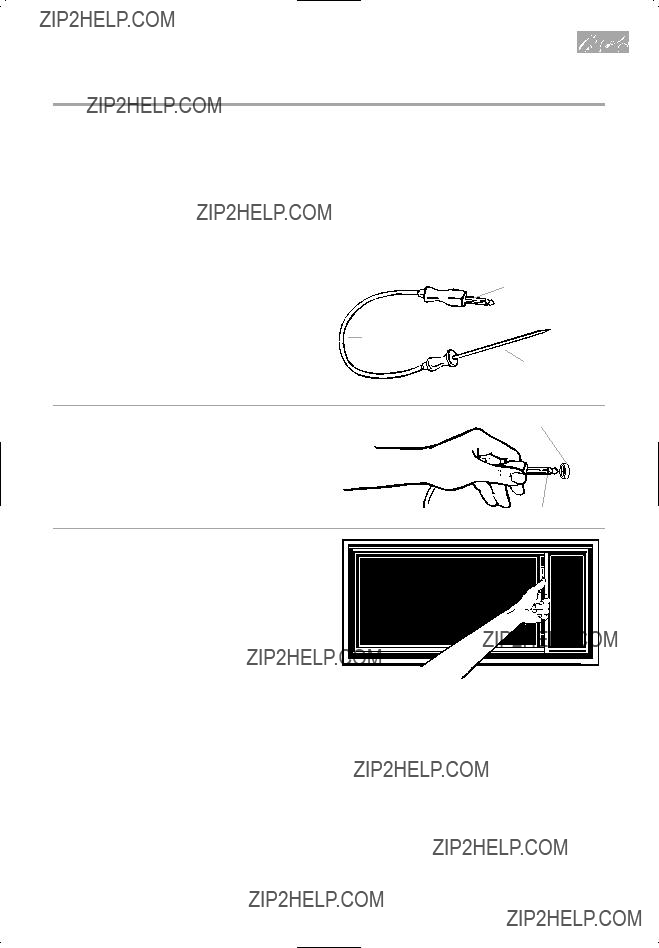
Microwave cooking
Cooking with the temperature probe
The Temperature Probe helps take the guesswork out of cooking roasts and larger casseroles. The probe is designed to turn off the oven when it senses the temperature you chose (between 90??F [32??C] and 200??F [93??C]). See a reliable cookbook for helpful information on cooking different types of food.
1. Insert probe into food.
NOTE: If you have not plugged in the Temperature Probe properly or if probe is defective, ???PROBE??? will appear on the Display, three tones will sound, and the oven will not turn on. After correcting the problem or removing the probe, touch START to clear the Display.
Plug
Insert at least 1???3 of the Temperature
Probe into the food. (See page 31.)
Make sure the probe does not touch any part of the oven interior.
Plug
3. Close the door.
continued on next page
29
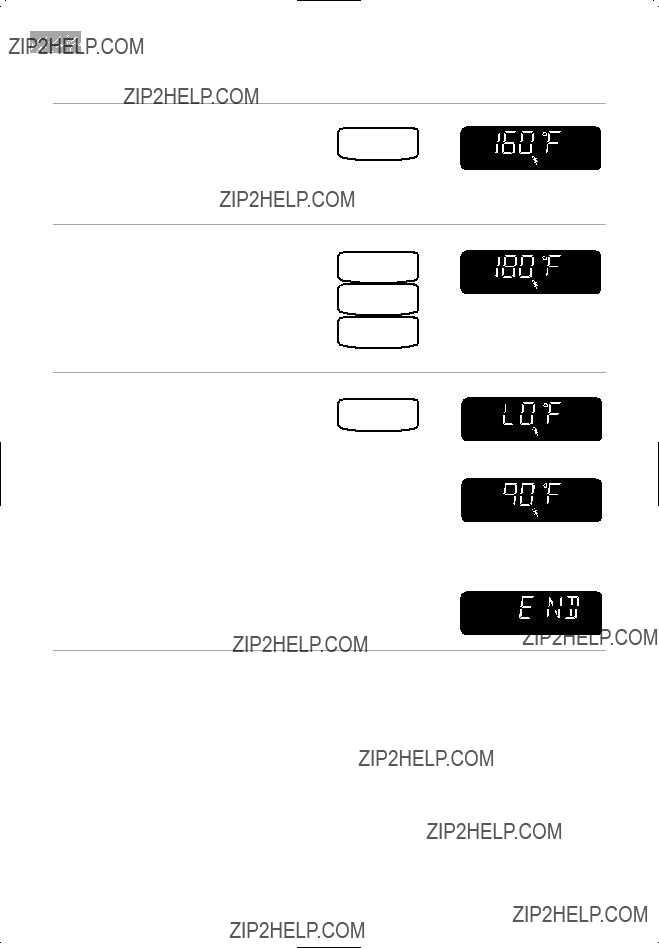
Microwave cooking
4. Choose setting.
NOTE: Food will automatically cook to 160??F (71??C) if you do not specify a final food temperature. If you want to specify a final food temperature, do Step 5. Oth- erwise, skip to Step 6.
5. Set desired final food temperature (optional).
Example for 180??F (82??C):
0
5??F (3??C). If the temperature does not change after 20 minutes, the Display will show ???CHECK??? and ???PROBE???.
When food reaches the desired temperature:
YOU SEE
To change final food temperature after oven has started:
1.Touch TEMP PROBE. You will see the current set temperature.
2.
3.Touch START.
NOTE: If you do not touch START within
1 minute after entering the new temperature, the oven will resume heating to the first tem- perature you set. You can ensure that your new temperature is set by touching TEMP PROBE (to display the set temperature for 3 seconds).
30
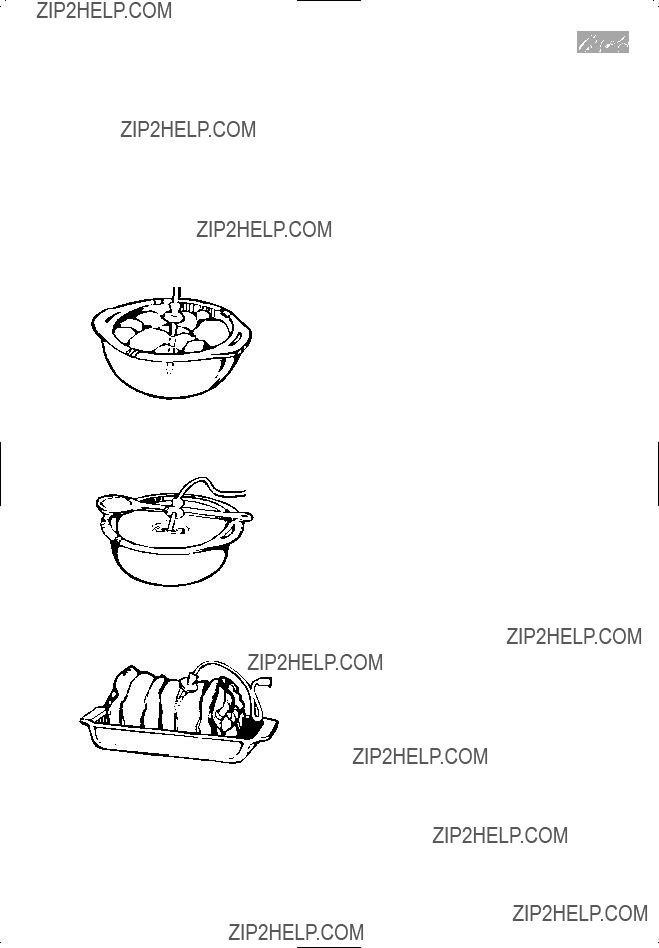
Microwave cooking
Temperature Probe cooking tips:
???Stir foods during cooking when recom- mended.
???Stir soups, casseroles, and drinks before serving.
???Cover roasts with foil after cooking and let stand a few minutes. Remove foil if you decide to cook it longer.
???Remove the probe from the oven when not cooking by temperature.
???For casseroles, the tip of the probe should be in the center of the food. Stir foods when recommended. Replace the probe.
???For liquids, balance the probe on a wooden spoon or spatula so the tip of the probe is in the center of the liquid.
???For roasts, the tip of the probe should be in the center of the largest muscle, but not touching fat or bone.
???Casseroles cooked using the Temperature Probe should be made from
precooked foods. Do not use raw meats, raw vegetables, and cream sauces in cas- seroles.
???Dry casseroles do not work well.
???Thaw frozen casseroles and meats in the microwave oven before inserting the probe.
???If you are cooking more than one individ- ual serving at the same time, such as mugs of soup, check the probe setting in several of the items ??? all the mugs may not heat at the same rate.
???Dry meat loaf mixtures do not work well.
???Check pork and poultry with thermometer in two to three places to ensure
adequate doneness.
???Roasts may vary in size, shape, and com- position. Use the Temperature Probe as a guide.
Do not:
???Let probe or probe cable touch any part of the oven interior.
???Let probe touch foil (if used). You can keep foil away from probe with wooden toothpicks. Remove foil if arcing occurs.
???Use paper, plastic wrap, or plastic contain- ers. They will be in the oven too long and might distort.
???Force probe into frozen food.
???Plug the pointed end of the Temperature Probe into the socket.
31
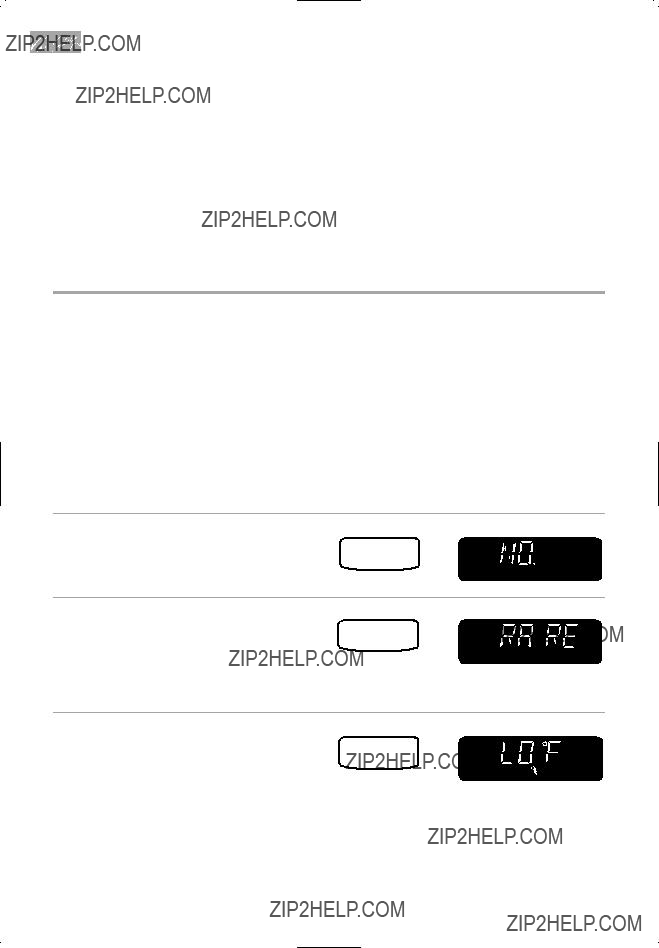
Microwave cooking
Removing and cleaning the Temperature Probe:
1.After oven has shut off, unplug the Temperature Probe using an oven mitt or hot pad.
2.Wipe probe with a hot, sudsy cloth and dry thoroughly. Use a plastic scouring pad to remove
3.You can place probe in the silverware basket of a dishwasher.
Using AUTO ROAST
AUTO ROAST lets you roast food with the Temperature Probe, without needing to enter a final food temperature. When the probe senses the preprogrammed final food temperature for the food category you chose, the oven will turn off.
1.Perform Steps 1, 2, and 3 under ???Cooking with the temperature probe??? on page 29.
2. Choose setting.
Example for Category 1 (Roast Beef [rare]):
4. Start oven.
32
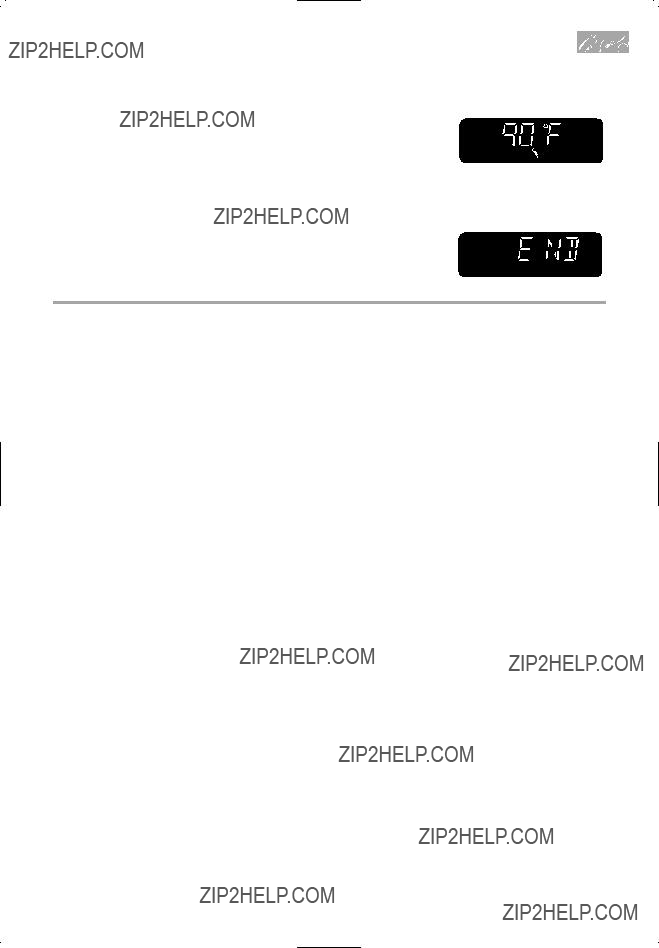
Microwave cooking
When food temperature reaches 90??F (32??C):
The displayed temperature will change each time food temperature increases by 5??F
When food reaches the desired temperature at the end of the cooking.
YOU SEE
YOU SEE
Auto roast chart
NOTE: Food to be roasted must be no less than .1 lb (45 g) and no more than 9.9 lbs (4.5 kg).
33
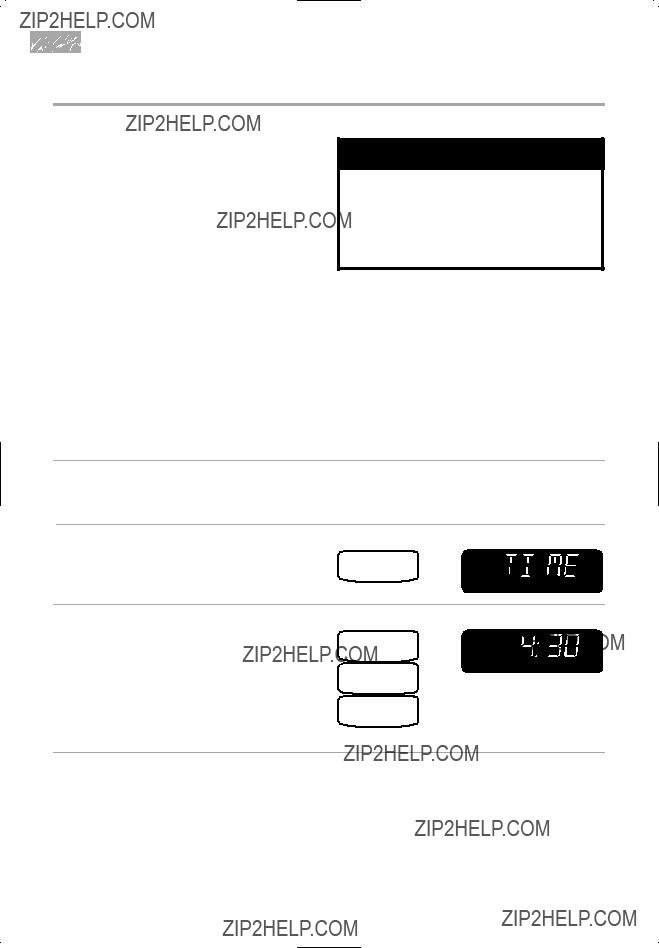
Microwave cooking
Using DELAY START
DELAY START lets you program your oven to begin cooking automatically at a time of day you choose. You can preprogram your oven up to 11 hours, 59 minutes in advance.
NOTES:
???If you hear the fan start when you touch START, you have not set the oven proper- ly. Touch CANCEL/OFF and start over.
???You can use DELAY START with high power or lower power cooking, tempera- ture probe cooking, and KEEP WARM.
???Do not use foods containing baking pow- der or yeast when using DELAY START. They will not rise properly.
1.Put food in oven and close door.
wWARNING
Food Poisoning Hazard
Do not let food sit in oven more than one hour before or after cooking.
Doing so can result in food poisoning or sickness.
2.Make sure clock is set to correct time of day.
3. Choose setting.
0
5. Enter cooking instructions for the function you want.
(cooking at high power or lower power, temperature probe cooking, KEEP WARM)
34
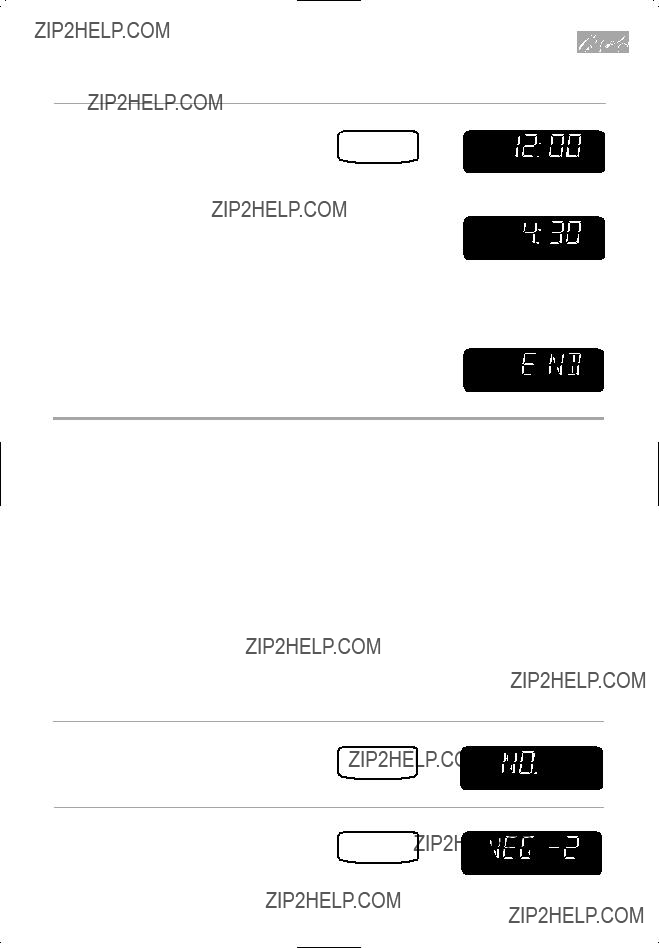
Microwave cooking
START
The oven will start cooking at the set time.
NOTE: If the door is opened before the start time is reached, the Display will
show ???DOOR??? and ???OPEN??? for 5 minutes or until the door is closed, whichever comes first. You must touch START to resume DELAY START.
At end of cooking time:
YOU SEE
(time of day)
YOU SEE
YOU SEE
Using AUTO COOK
AUTO COOK lets you cook common micro-
the rest.
NOTES:
???If covering foods, use a loose cover to allow sensor to detect moisture.
???See ???Microwave cooking chart??? on page 64 for cooking with cooking time and Cook Power.
???You can set AUTO COOK as one of your steps in
1.Put food in oven and close door.
2. Choose AUTO COOK.
AUTO COOK
ENTER
SENSOR
COOK
(Frozen Vegetables):
35
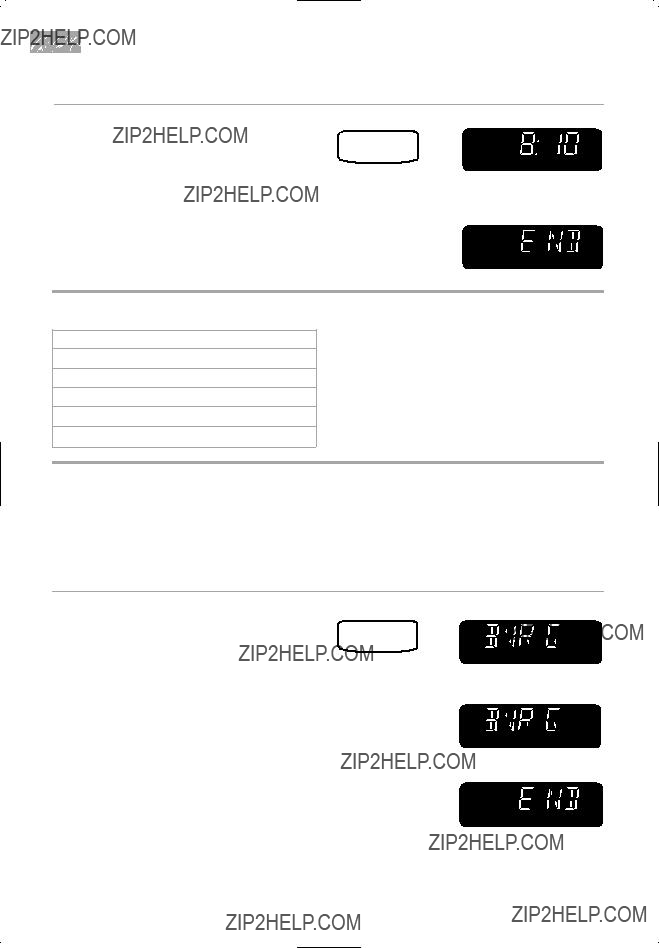
Microwave cooking
4. Start oven.
When oven detects vapor from food, cooking time is displayed.
At end of cooking time:
SENSOR
START
COOK
TIME
(this time will vary)
YOU SEE
Auto cook chart
CATEGORY FOOD
1Frozen Entree
2Casserole (Refrigerated)
3Bread
4Fresh/Canned Vegetables
5Frozen Vegetables
Using BEVERAGE
BEVERAGE lets you heat or reheat a bev- erage by touching just one pad.
1.Place cup of beverage in oven and close door.
COMB START? TIMER
36
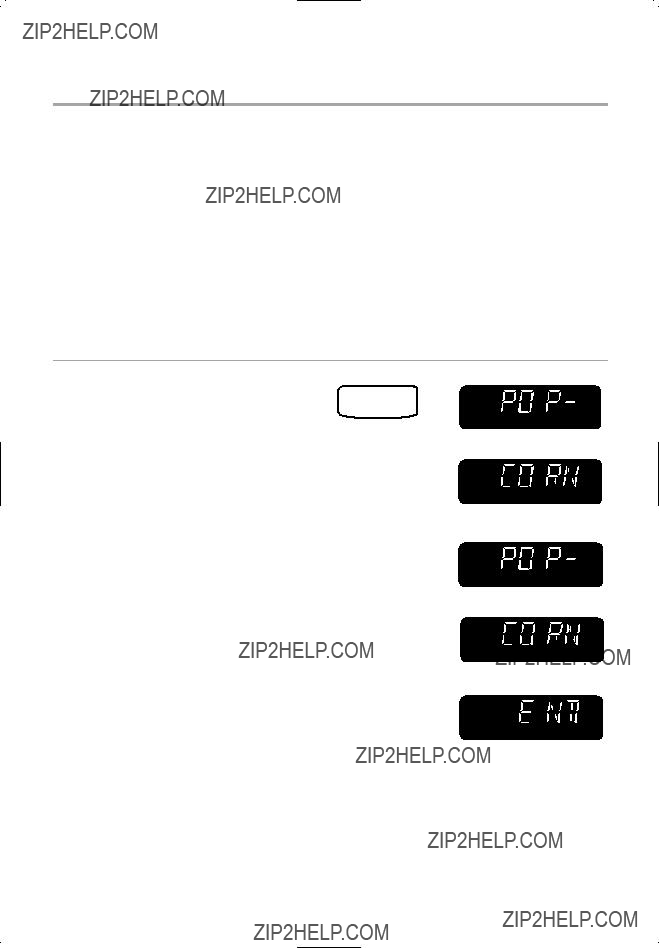
Microwave cooking 


Using POPCORN
POPCORN lets you pop commercially pack- aged microwave popcorn by touching just one pad.
Pop only one package at a time. If you are using a microwave popcorn popper, follow manufacturer???s instructions.
Try several brands to decide which gives best popping results. For best results, use fresh bags of popcorn. Cooking performance may vary with brand and fat content.
1.Place bag on rack and close door.
2. Choose POPCORN.
DELAY
OZ
LBS

 COOK CONV2 3 4
COOK CONV2 3 4
COMB START? TIMER
37
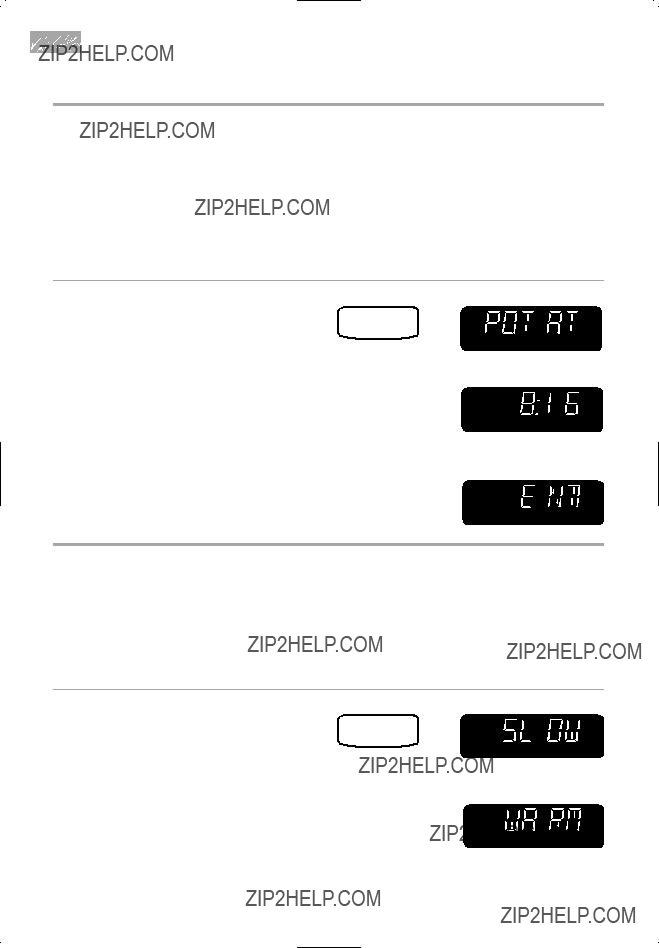
Microwave cooking
Using BAKED POTATO
BAKED POTATO lets you bake a potato (about 10 oz. [284 g]) by touching just one pad. A sensor in your oven detects the vapor released by the potato, and the amount of vapor detected
tells the oven how long to bake your potato. Before baking, remember to pierce potato with a fork several times. After cooking, let potato stand 5 minutes wrapped in foil.
1.Place potato on paper towel in oven and close door.
2. Choose BAKED POTATO.
After 3 seconds, the oven will begin heating.
When oven detects vapor from potato, heating time is displayed. Example:
YOU SEE
(this time will vary)
DELAY
OZ
LBS

 COOK CONV2 3 4
COOK CONV2 3 4
COMB START? TIMER
Using SLOWCOOK/SIMMER
SLOWCOOK/SIMMER lets you stew or simmer food by touching just one pad. A sensor in your oven detects the vapor
released by the food, and the amount of vapor detected tells the oven how long to stew or simmer your food.
1.Place food in oven and close door.
2. Choose SLOWCOOK/SIMMER.
After 3 seconds, the oven will begin heating at 70% Cook Power. The oven will then cook at 50% Cook Power and finally at 30% Cook Power.
After 2nd and 3rd stages, oven will simmer food.
Oven will keep food warm at 10% Cook Power for 99 minutes, 99 seconds.
YOU SEE
38
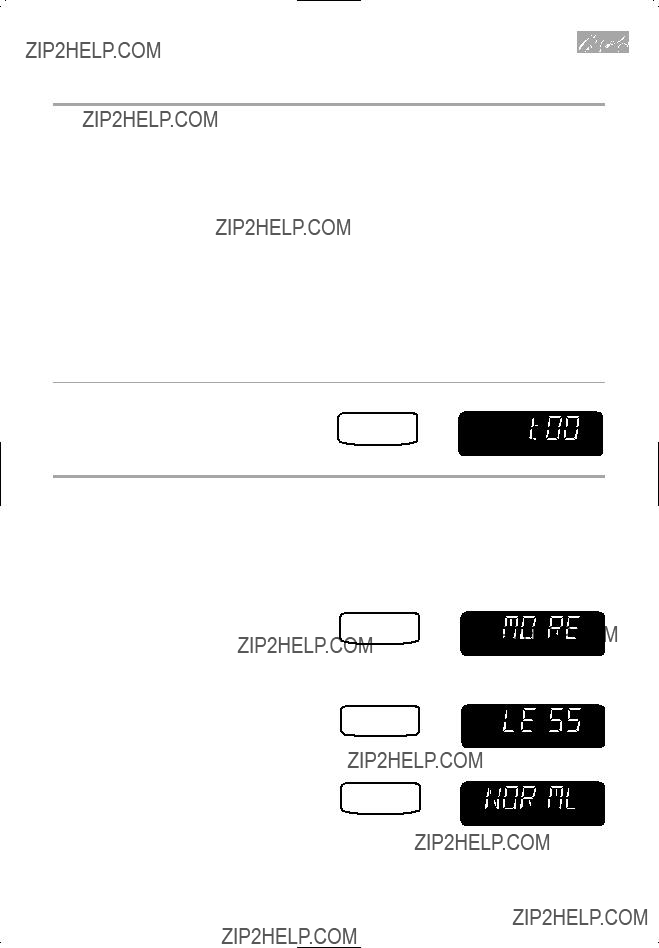
Microwave cooking
Using EASY MINUTE
EASY MINUTE lets you cook food for
1 minute at 100% Cook Power or add an extra minute to your cooking cycle. You can also use it to extend cooking time in multi- ples of 1 minute, up to 99 minutes.
NOTES:
???To extend cooking time in multiples of
1 minute, touch EASY MINUTE repeatedly during cooking.
???You can enter EASY MINUTE only after closing the door, after touching CAN- CEL/OFF, or during cooking.
???If you touch EASY MINUTE during cook- ing, the oven will cook at the currently selected Cook Power. If you touch EASY MINUTE after cooking is over, the oven will cook at 100% Cook Power.
???You cannot use EASY MINUTE with
POPCORN, AUTO ROAST, BEVERAGE, AUTO COOK, or CUSTOM DEFROST.
???You cannot use EASY MINUTE to start the oven if any program, other than the Minute Timer, is on the Display.
1. Make sure food is in oven.
Adding or subtracting cook time
If a preset cook time is too long or too short, you can increase or decrease the cook time by 10% after choosing the function. You can only increase or decrease cook time before cooking starts.
39
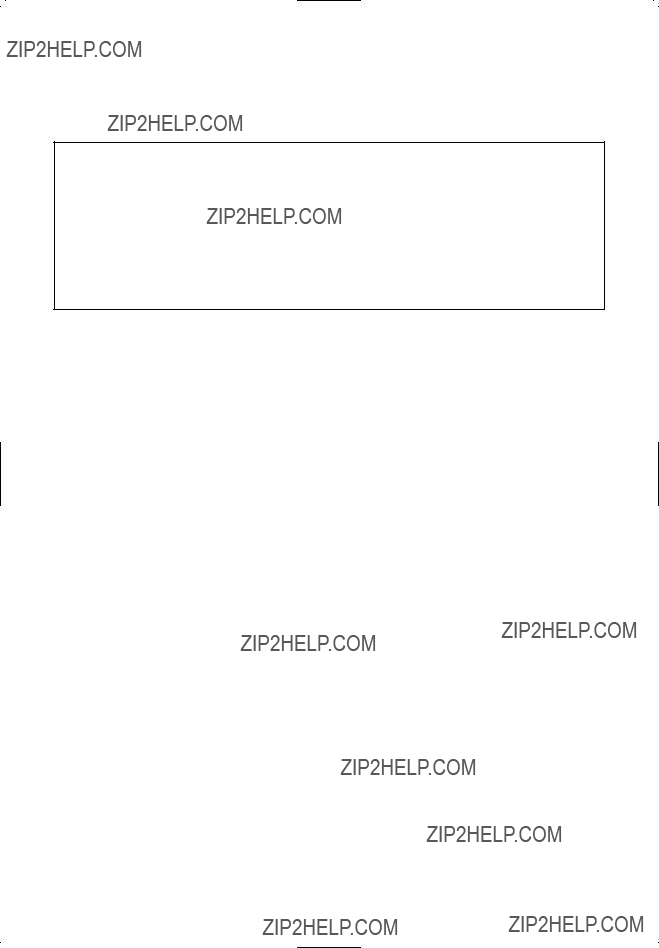
Convection Cooking
This section gives you instructions for operating each convection function. Please read these instructions carefully.
IN THIS SECTION
How convection cooking works
Convection cooking circulates hot air through the oven cavity with a fan. The con- stantly moving air surrounds the food to heat the outer portion quickly. Your oven uses convection cooking whenever you use the Convection Command Pads.
Helpful hints for convection cooking:
???Do not cover baking rack with aluminum foil. It interferes with the flow of air that cooks the food.
???Round pizza pans are excellent cook- ware for many
???Use convection cooking for items like souffles, breads, cookies, angel food cakes, pizza, and for some meat and fish cooking.
???You do not need to use any special techniques to adapt your favorite oven recipes to convection cooking; however, you may need to lower some tempera- tures or reduce some cooking times from the convection oven cooking directions. See examples in the charts in this section.
???When baking cakes, cookies, breads, rolls, or other baked foods, most recipes call for preheating. Preheat the empty oven just as you do a regular oven. You can start heavier dense foods such as meats, casseroles, and poultry without preheating.
???All heatproof cookware or metal utensils can be used in convection cooking.
???As in conventional cooking, the distance of the food from the heat source affects cooking results. Follow reliable cookbook recipes and refer to the charts in this Use and Care Guide.
???Use metal cookware only for convection cooking. Never use for microwave or com- bination cooking since arcing and damage to the oven may occur.
???After preheating, if you do not open the door, the oven will automatically hold at the preheated temperature for 30 minutes.
???You can set up to three convection cycles. (Example for two crust pies: you can set the oven to preheat for baking at 425??F [218??C] and to finish baking at 350??F [177??C].)
???Use cookware that will not melt or burn in the hot oven. Do not use light plastic con- tainers, plastic wraps, or paper products during any convection combination cycle.
40
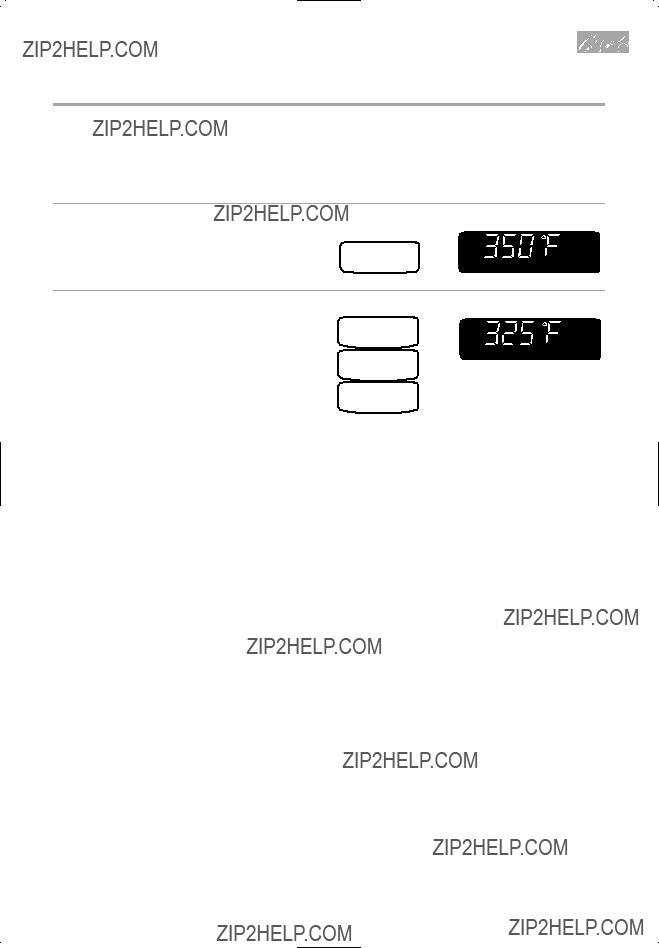
Convection cooking
Convection baking without preheating
(meats, casseroles, and poultry)
1. Put food in oven and close the door.
2. Choose setting.
Oven will automatically cook at 350??F (177??C).
3. Set baking temperature (optional).
You can enter a temperature between 150??F (66??C) and 450??F (232??C). Example for 325??F (163??C):
TOUCHYOU SEE
TEMP CONV
2
entered, touch CONVECTION BAKE before entering a bake time. You can then
41
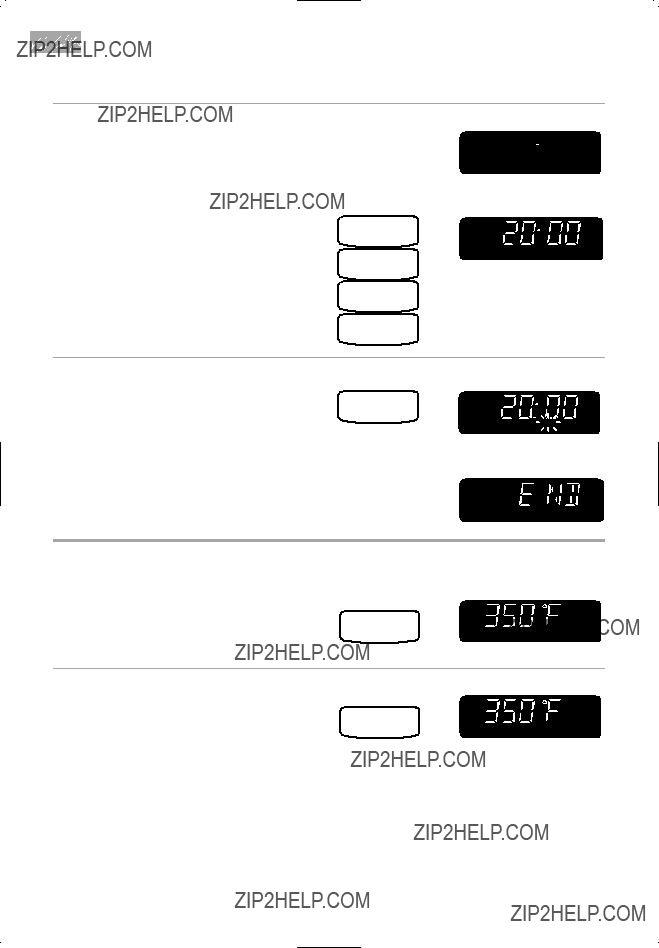
Convection cooking
4. Set cooking time.
One second after entering bake temperature:
You can enter a time up to 199 minutes, 99 seconds.
YOU SEE
ENTER
 CONV
CONV
TIME
2
0
0
0
 CONV
CONV
START? TIME
5. Start oven.
NOTE: You can see the cooking temperature anytime during cooking by touching CONVECTION BAKE. Cooking temperature will show for 3 seconds.
At end of cooking time:
START
COOK
CONV
TIME
(time will count down)
YOU SEE
Convection baking with preheating
1. Choose setting.
2.Set preheat/cooking temperature.
42
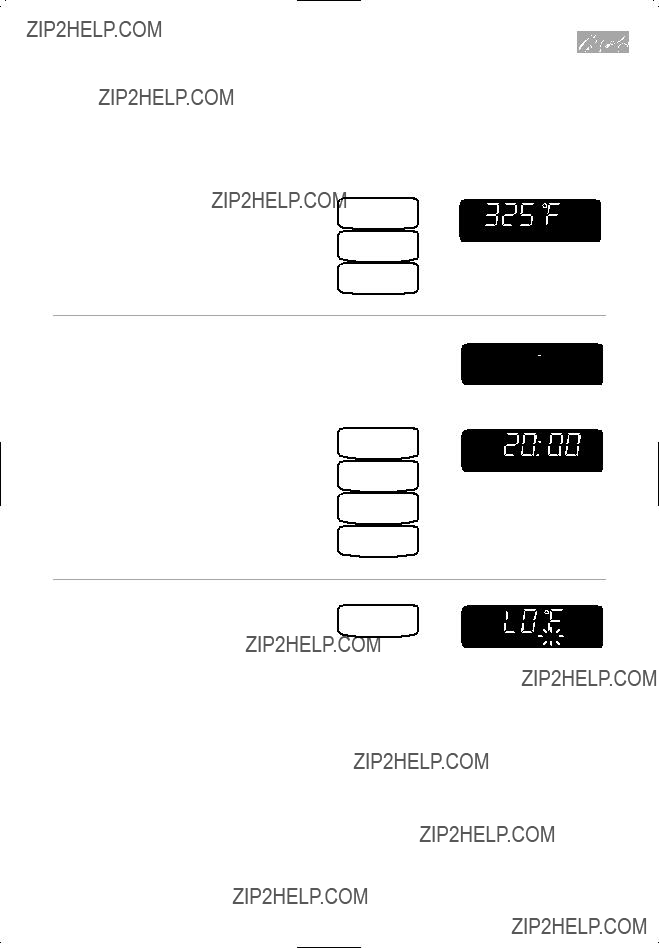
Convection cooking
The oven will automatically preheat/cook at 350??F (177??C). If you want to change the preheat/cooking temperature, follow the example below. If you want to preheat/cook at 350??F (177??C), go to Step 3.
Example for 325??F (163??C):TOUCHYOU SEE
3. Set cooking cycle cooking time.
One second after entering bake temperature:
You can enter a time up to 199 minutes, 99 seconds.
YOU SEE
ENTER
PREHEAT
 CONV
CONV
TIME
Example for 20 minutes:TOUCHYOU SEE
2
PREHEAT
0
0
4. Start oven.
When the oven temperature reaches 150??F (66??C), the temperature will be displayed. The displayed temperature will change each time temperature goes up by five degrees.
NOTES:
???If you open the door or touch CANCEL/OFF during preheating, pre- heating will stop. To resume preheating, close the door and
touch START.
???When the oven reaches the set pre- heat temperature, two tones will sound and the oven will automatically hold that temperature for 30 minutes. The Display will show the set temperature.
COOK
TEMP CONV
(display shows oven is preheating)
continued on next page
43
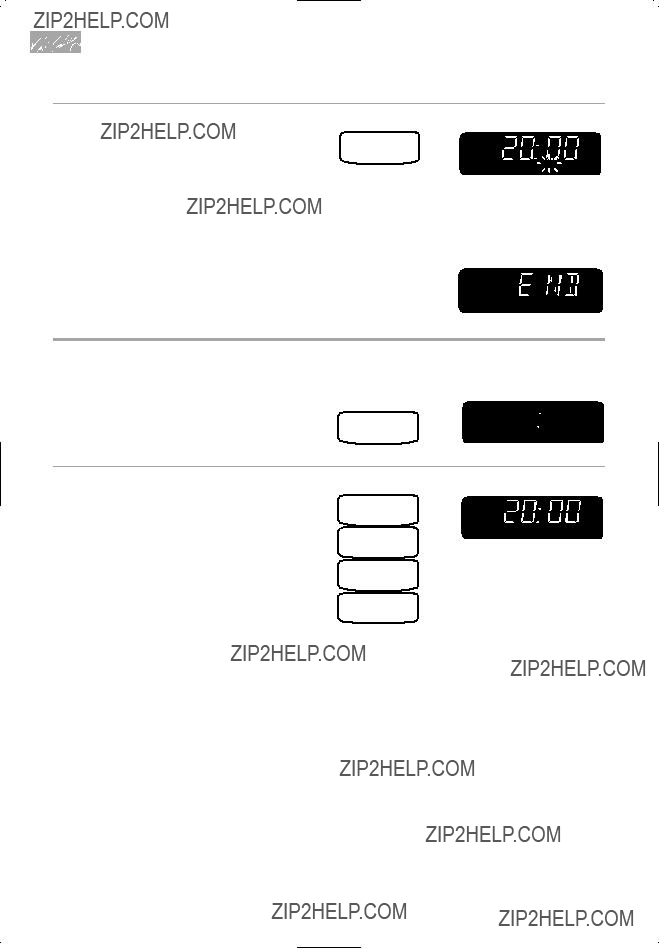
Convection cooking
5.After preheating, open the door, put food in oven, and close the door.
NOTE: You can see the cooking temperature anytime during cooking by touching CONVECTION BAKE. The cooking temperature will show for
3 seconds.
At end of cooking time:
START
COOK
CONV
TIME
(time for cook cycle will count down)
YOU SEE
Convection broiling
1. Choose setting.
TIME
0
0
44
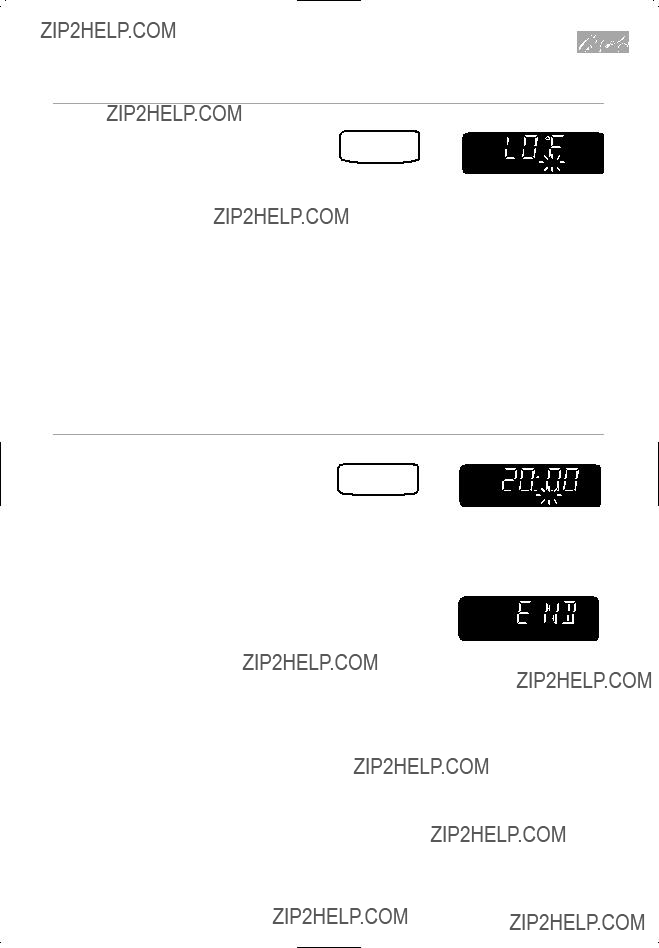
Convection cooking
???If you open the door or touch CANCEL/OFF during preheating, preheating will stop. To resume preheating, close the door and touch START.
???When the oven reaches the set preheat temperature, two tones will sound and the oven will automatically hold that temperature for 30 minutes. The Display will show the set temperature.
4.After preheating, open the door, put food in oven, and close
the door.
NOTE: You can see the cooking temperature anytime during cooking by touching CONVECTION BROIL. The cooking temperature will show for
3 seconds.
START
COOK
CONV
TIME
(time for cook cycle will count down)
ENTER
SENSOR
PREHEAT
WEIGHT
AUTO COOK DEFR TEMP
ROAST PWR QTY PROBE
COMB START? TIMER
45
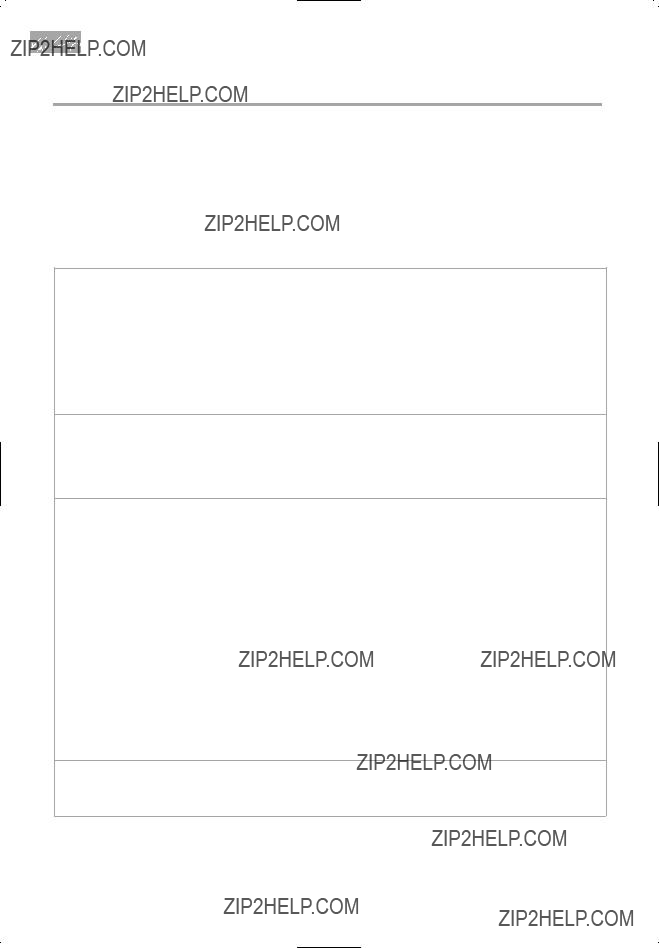
Convection cooking
Convenience foods cooking chart
Convection cooking of convenience foods is similar to cooking in a conventional oven. Select items that fit conveniently on the turntable, such as an
package directions for preparation and selecting the correct container. Because of the great variety of foods available, times given here are approximate. It is advisable to always check food about 5 minutes before the minimum recommended time, and cook longer only if needed. Use oven mitts to insert or remove items from the oven.
Bake in metal or ovenproof pan on Metal Rack.
Bake six at a time on metal round cookie sheet on Metal Rack.
NOTE: Use the normal position when cooking with the Metal Rack. (See page 15.)
46
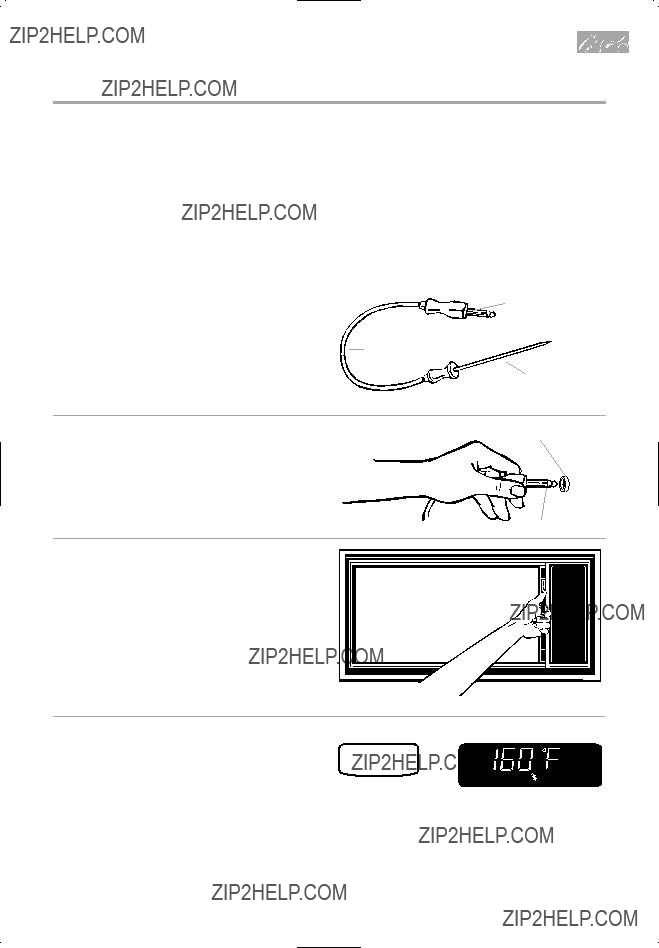
Convection cooking
Convection cooking with the temperature probe
The Temperature Probe helps take the guesswork out of cooking roasts and larger casseroles. The probe is designed to turn off the oven when it senses the temperature you chose (between 90??F [32??C] and 200??F [93??C]). See a reliable cookbook for helpful information on cooking different types of food.
1. Insert probe into food.
Insert at least 1???3 of the Temperature Probe into the food. (See page 33.)
NOTES:
???If you have not plugged in the Temperature Probe properly or if probe is defective, ???PROBE??? will appear on the Display, three tones will sound, and the oven will not turn on.
???For correct probe temperatures for different foods, see the ???Temperature probe convection cooking chart??? on page 49.
Plug
Cable
Probe
2.Place food in oven and plug probe into socket on oven wall.
Socket
Make sure the probe does not touch any part of the oven interior ??? including the rack.
Plug
3. Close the door.
4. Choose temperature probe setting.
The oven will automatically heat to a final food temperature of 160??F (71??C). If you want to change the final food temperature, follow Step 5 below. If you want a final food temperature of 160??F (71??C), skip Step 5 below.
47
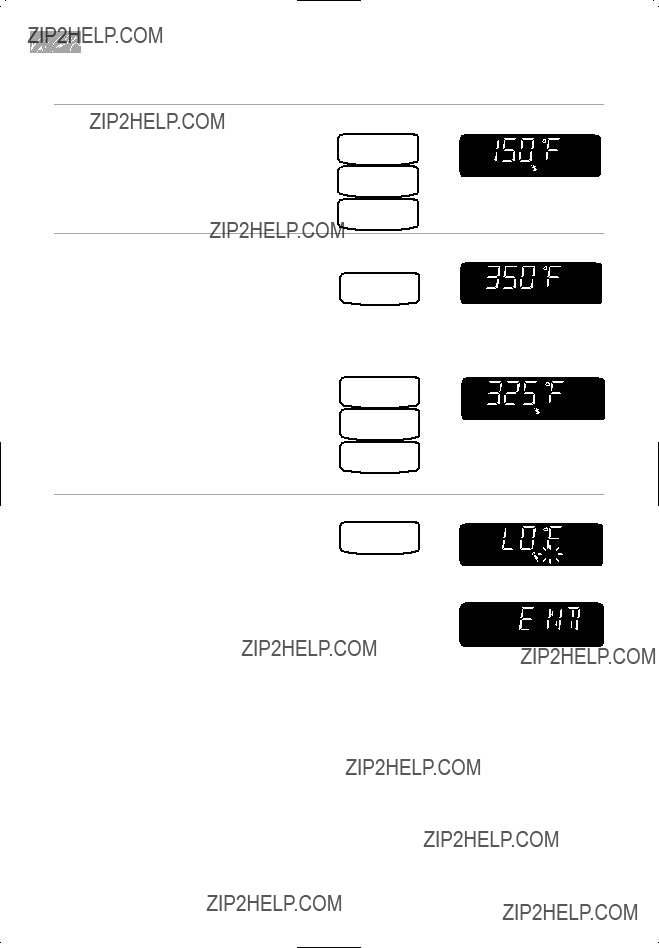
Convection cooking
5.Set desired final food temperature (optional).
Example for 150??F (66??C):
TOUCHYOU SEE
0
6. Set convection cooking temperature.
The oven will automatically cook at 350??F (177??C). If you want to change the cooking temperature, follow the example below. If you want to cook at 350??F (177??C), go to Step 7.
3
2
5
7. Start oven.
When food temperature reaches 90??F (32??C), the Display will show the actual temperature of the food as it increases to the desired temperature.
START
COOK
TEMP CONV
PROBE
DELAY
OZ
LBS

 COOK CONV2 3 4
COOK CONV2 3 4
COMB START? TIMER
Removing and cleaning the Temperature Probe:
1.After oven has shut off, unplug the Temperature Probe using an oven mitt or hot pad.
2.Wipe probe with a hot, sudsy cloth and dry thoroughly. Use a plastic scouring pad to remove
3.You can place probe in the silverware basket of a dishwasher.
48

Convection cooking
Temperature probe convection cooking chart
NOTE: Use the normal position when cooking with the Metal Rack. (See page 15.)
49

Convection cooking
NOTE: Use the normal position when cooking with the Metal Rack. (See page 15.)
50
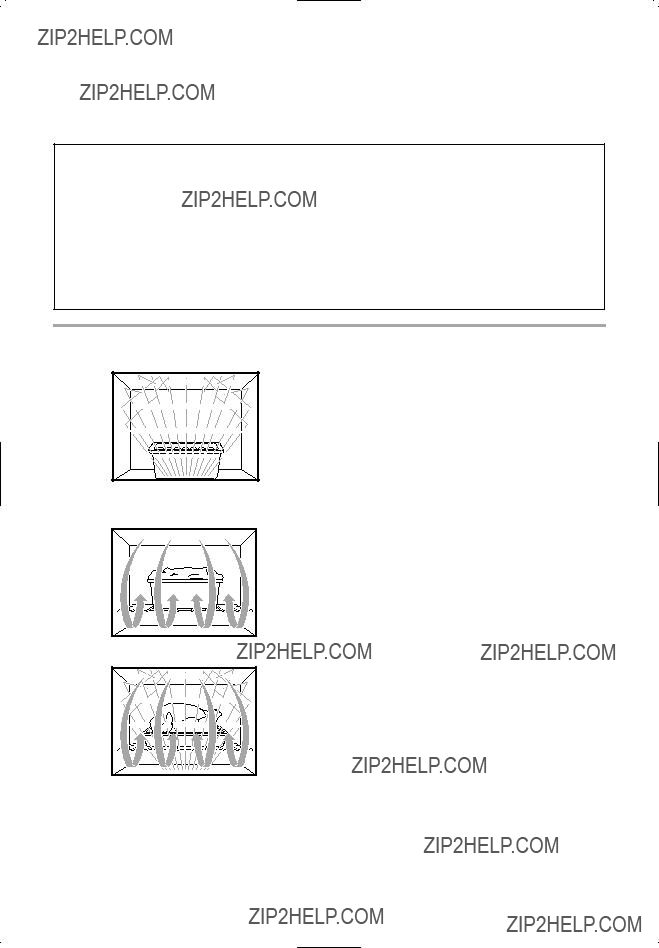
Combination Cooking
This section gives you instructions for operating each combination cooking function. Please read these instructions carefully.
IN THIS SECTION
How combination cooking works
Combination microwave/convection
Sometimes combination
meats juicy on the inside and crispy on the outside. In combination cooking, the convection heat and microwave energy alternate automatically. Your oven has two
Helpful hints for combination cooking:
???Meats may be roasted directly on the Metal Rack or in a shallow roasting pan placed on the rack. When using the Metal Rack, please refer to the section about ???Using the metal rack.???
???Less tender cuts of beef can be roasted and tenderized using oven cooking bags.
???When baking, check for doneness after cooking time is up. If not completely done, let stand in oven for a few minutes to complete cooking.
NOTE: During combination baking, some cookware may cause arcing when it comes in contact with the oven walls or metal accessory racks. Arcing is a discharge of electricity that occurs when microwaves come in contact with metal. If arcing occurs, place a heatproof dish between the pan and the Metal Rack. If arcing occurs with other cookware, stop using it for combination cooking.
51

Combination cooking
Combination baking/roasting without preheating
1. Put food in oven and close door.
2. Choose setting.
Example for baking:
The oven will automatically cook at 350??F (177??C) for combination baking and 300??F (149??C) for combination roasting. If you want to change the cook- ing temperature, follow Step 3 below. If you want to cook at the default tempera- ture, skip Step 3 below.
COMB
3.Set baking/roasting temperature (optional).
Example for 325??F (163??C):
NOTE: To clear the temperature you en- tered, touch COMBINATION BAKE (when baking) or COMBINATION ROAST (when roasting) before entering a cooking time. You can then
TOUCHYOU SEE
5
4. Set cooking time.
One second after entering cook temperature:
You can enter a time up to 199 minutes, 99 seconds.
2
YOU SEE
ENTER
COMBTIME
YOU SEE
0
0
0
COMB START? TIME
5. Start oven.
NOTE: You can see the cooking temperature anytime during cooking by touching COMBINATION BAKE (when baking) or COMBINATION ROAST (when roasting). Cooking temperature will show for 3 seconds.
START
COOK
COMBTIME
(time will count down)
52
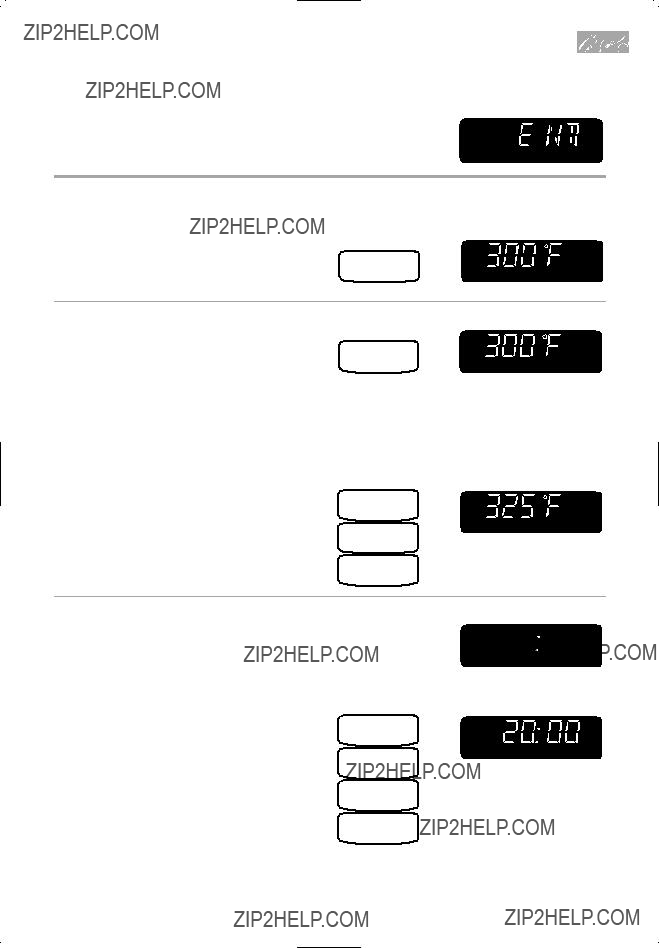
Combination cooking
ENTER
SENSOR
PREHEAT
WEIGHT
AUTO COOK DEFR TEMP
ROAST PWR QTY PROBE
DELAY
OZ
LBS

 COOK CONV2 3 4
COOK CONV2 3 4
COMB START? TIMER
Combination baking/roasting with preheating
COMB
2. Set preheat/cooking temperature.
The oven will automatically cook at 350??F (177??C) for combination baking and 300??F (149??C) for combination roasting. If you want to change the preheat/cooking temperature, follow the example below. If you want to preheat/cook at the default temperature, go to Step 3.
COMB
Example for 325??F (163??C):TOUCHYOU SEE
5
3. Set cooking cycle cooking time.
One second after entering cook temperature:
YOU SEE
ENTER
PREHEAT
2
continued on next page
53
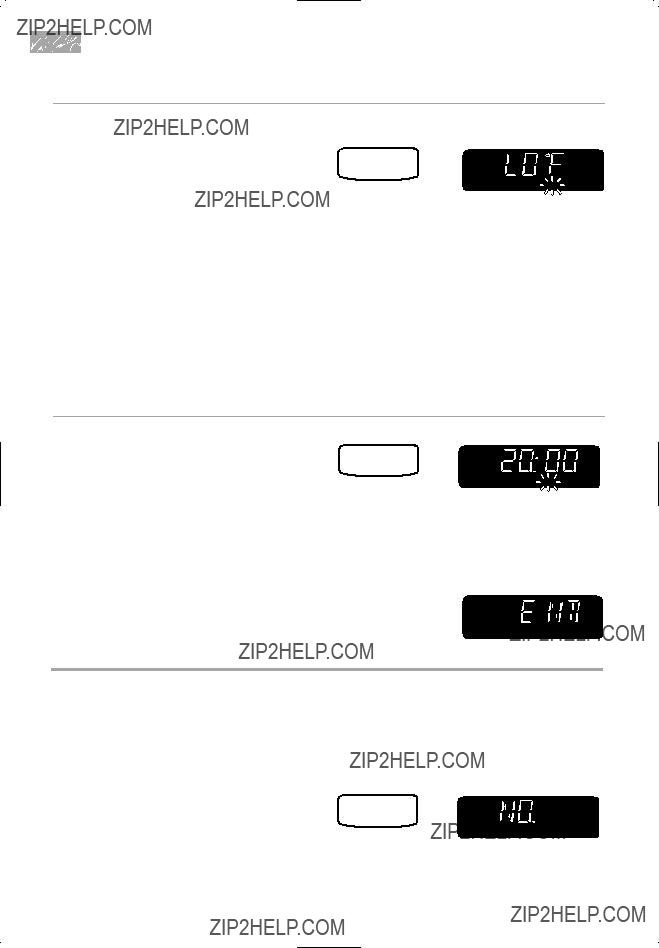
Combination cooking
4. Start oven.
???If you open the door or touch CANCEL/OFF during preheating, preheating will stop. To resume preheating, close the door and touch
START.
???When the oven reaches the set
5.After preheating, open the door, put food in oven, and close the door.
NOTE: You can see the cooking temperature anytime during cooking by touching COMBINATION BAKE (when baking) or COMBINATION ROAST (when roasting). Cooking temperature will show for 3 seconds.
START
COOK
COMBTIME
(time for cook cycle will count down)
ENTER
SENSOR
PREHEAT
WEIGHT
AUTO COOK DEFR TEMP
ROAST PWR QTY PROBE
DELAY
OZ
LBS

 COOK CONV2 3 4
COOK CONV2 3 4
COMB START? TIMER
Using AUTO COMBINATION
AUTO COMBINATION lets you cook with both microwaves and convection heat, without needing to set a cooking time or Cook Power. All you do is choose the
1. Choose AUTO COMBI.
category of the food you are cooking and enter the weight or quantity. See the ???Auto combination chart??? on the next page for the settings available to you.
COMB
54
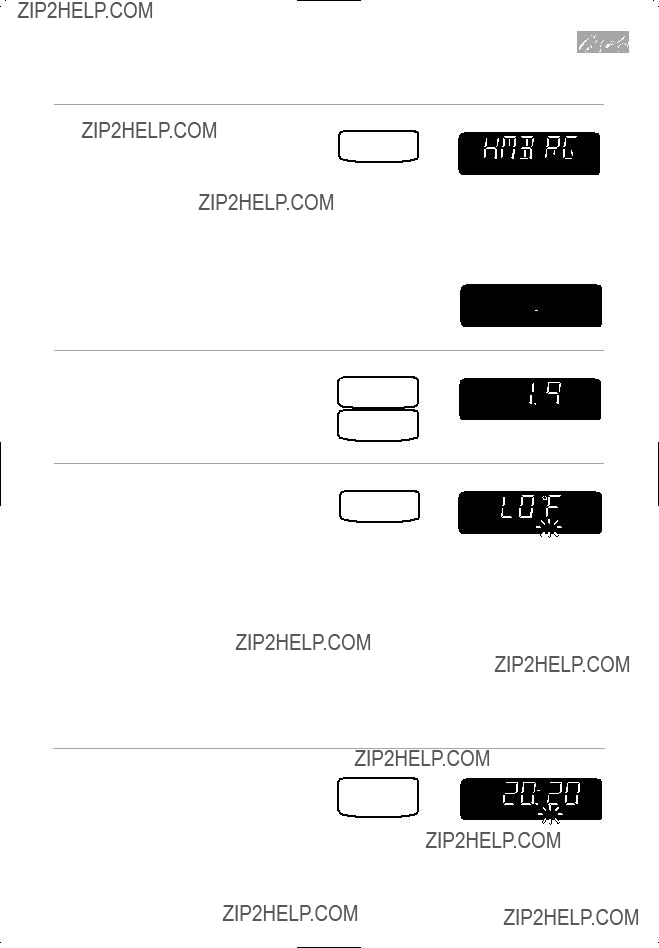
Combination cooking
2. Choose food setting.
See chart on next page for available settings.
Example for setting 1 (hamburger, broiled):
NOTE: If you have entered the wrong setting, you have 3 seconds to change the setting. After 3 seconds, you must touch AUTO COMBI to start over.
COMB
LBS
3. Enter food weight or quantity.
NOTE: If you have entered the wrong weight or quantity, touch AUTO COMBI to start over.
TOUCHYOU SEE
LBS
9
4. Start oven.
When the oven temperature reaches 90??F (32??C), the temperature will be displayed. The displayed temperature will change each time the temperature goes up by 5 degrees.
(display shows oven is preheating)
If you open the door or touch CANCEL/OFF during preheating, preheating will stop. To resume preheating, close the door and touch
START.
???When the oven reaches the set preheat temperature, two tones will sound and the oven will automatically hold that tempera- ture for 30 minutes. The Display will show the set temperature.
(cooking time counts down)
continued on next page
55
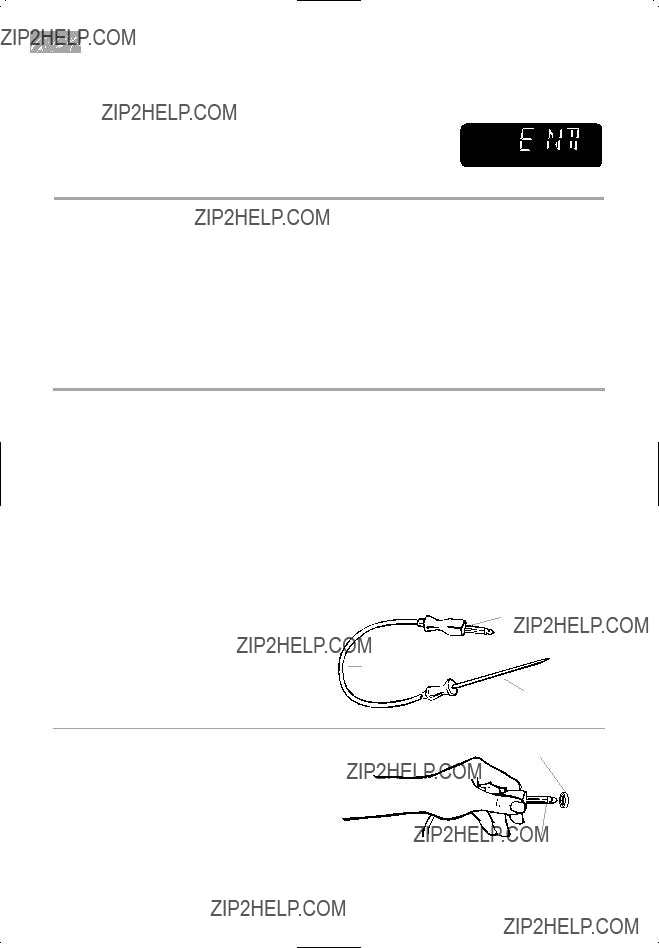
Combination cooking
ENTER
SENSOR
PREHEAT
WEIGHT
AUTO COOK DEFR TEMP
ROAST PWR QTY PROBE
DELAY
OZ
LBS

 COOK CONV2 3 4
COOK CONV2 3 4
COMB START? TIMER
Auto combination chart
Combination cooking with the temperature probe
The Temperature Probe helps take the guesswork out of cooking roasts and larger casseroles. The probe is designed to turn off the oven when it senses the temperature you chose (between 90??F [32??C] and 200??F [93??C]). See a reliable cookbook for helpful information on cooking different types of food.
NOTES:
???If you have not plugged in the Tempera- ture Probe properly or if probe is defective, ???PROBE??? will appear on the Display, three tones will sound, and the oven will not
turn on.
???For correct probe temperatures for differ- ent foods, see the ???Temperature probe combination cooking chart??? on pages 61 and 62.
1. Insert probe into food.
Insert at least 1???3 of the Temperature Probe into the food. (See page 33.)
Plug
Cable
Probe
2.Place food in oven and plug probe into socket on oven wall.
Socket
Make sure the probe does not touch any part of the oven interior ??? including
the rack.
Plug
56
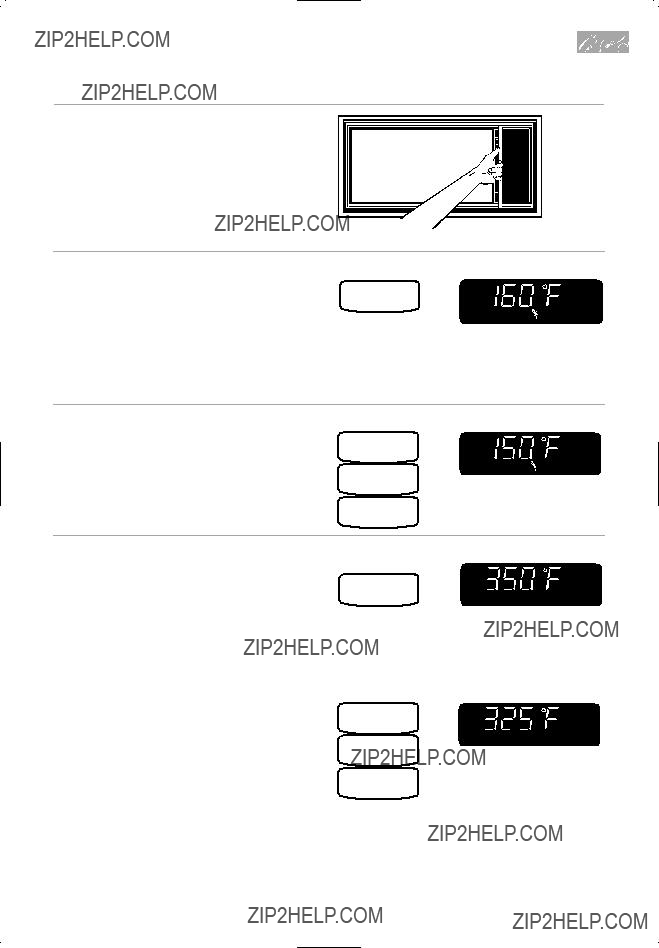
Combination cooking
3. Close the door.
4. Choose temperature probe setting.
The oven will automatically heat to a final food temperature of 160??F (71??C). If you want to change the final food temperature, follow Step 5 below. If you want a final food temperature of 160??F (71??C), skip Step 5 below.
5.Set desired final food temperature (optional).
Example for 150??F (66??C):
TOUCHYOU SEE
0
6. Set combination cooking temperature.
The oven will automatically cook at 350??F (177??C) (when baking) or 300??F (149??C) (when roasting). If you want to change the cooking temperature, follow the example below. If you want to cook at the default temperature, go to Step 7.
Example for 325??F (163??C)
COMB
TOUCHYOU SEE
5
continued on next page
57
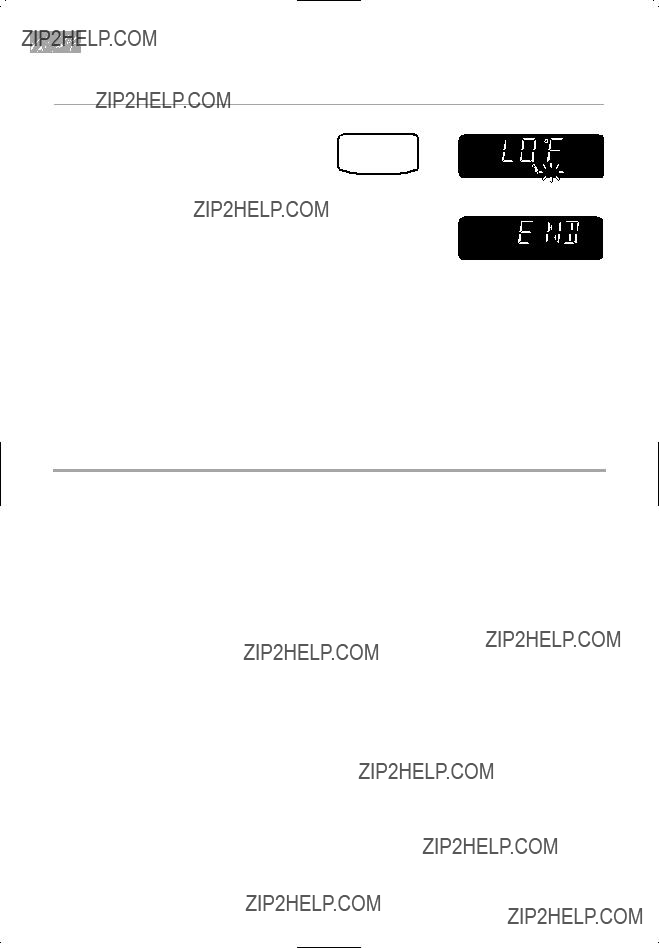
Combination cooking
7. Start oven.
When food temperature reaches 90??F (32??C), the Display will show the actual temperature of the food as it increases to the desired temperature.
When food reaches desired tempera- ture:
TOUCHYOU SEE
Removing and cleaning the
Temperature Probe:
1.After oven has shut off, unplug the Temperature Probe using an oven mitt or hot pad.
2.Wipe probe with a hot, sudsy cloth and dry thoroughly. Use a plastic scouring pad to remove
3.You can place probe in the silverware basket of a dishwasher.
Temperature probe combination cooking chart
58

Combination cooking
Cook in microwave- proof and heatproof baking dish. Let stand 10 min after cooking (covered).
59
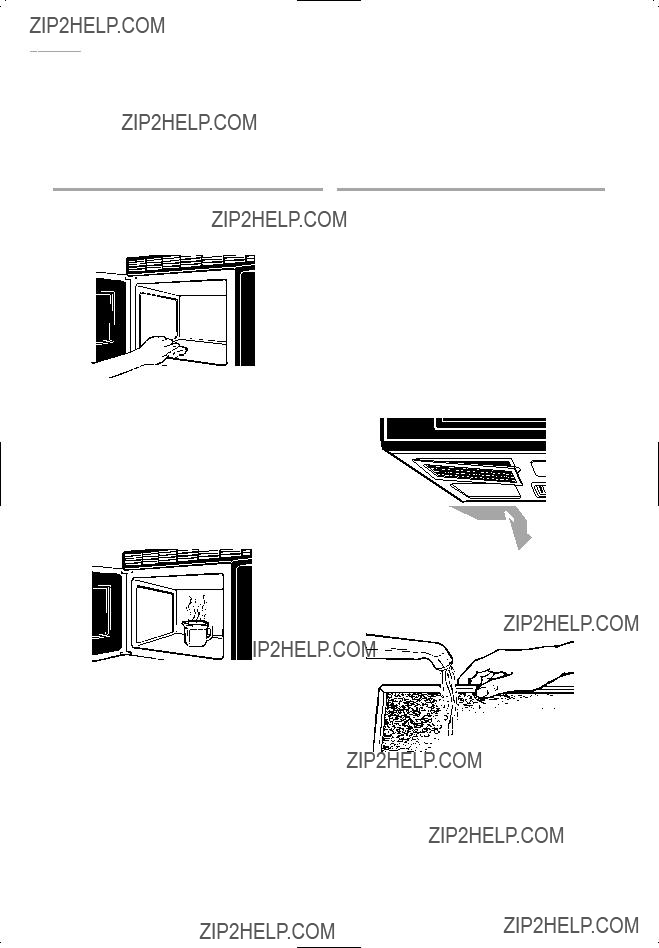
Caring for Your Microwave- Convection Hood Combination
To make sure your microwave oven looks good and works well for a long time, you should maintain it properly. For proper care, please follow these instructions carefully.
Cleaning the microwave oven
For interior surfaces: Wash often with warm, sudsy water and a sponge or soft cloth. Use only mild, nonabrasive soaps or a mild deter- gent. Be sure to keep the areas clean where the door and oven frame touch when closed. Wipe well with clean water.
For exterior surfaces and control panel:
Use a soft cloth with spray glass cleaner. Apply spray glass cleaner to soft cloth; do not spray directly on oven.
For stubborn soil, boil a cup of water in the oven for 2 or 3 minutes. Steam will soften the soil. To get rid of odors inside the oven, boil a cup of water with lemon juice or vinegar.
NOTE: Abrasive cleansers,
Cleaning the metal rack
???Wash by hand with a mild detergent and a soft or nylon scrub brush. Dry completely.
???Do not use abrasive scrubbers or cleansers to clean rack.
Caring for the filters
The grease filters should be removed and cleaned often, at least once a month.
NOTE: If your microwave hood combination is installed to recirculate air, a charcoal filter (Part No. 4395956) can be ordered. It should be replaced every
Grease filters:
1.Disconnect power or unplug microwave oven.
2.To remove grease filters, slide each filter to the side. Pull filters downward and push to the other side. The filter will drop out.
3.Soak grease filters in hot water and a mild detergent. Scrub and swish to remove embedded dirt and grease.Rinse well and shake to dry. Do not use ammonia or place in a dishwasher. The aluminum will darken.
60

Caring for your
4.To replace grease filters, slide filter in the frame slot on one side of the opening. Push filter upward and push to the other side to lock into place.
5.Reconnect power or plug in microwave oven.
Charcoal filter:
1.Disconnect power or unplug microwave oven.
2.To remove charcoal filter: remove the vent cover mounting screws.
3.Tip the cover forward, then lift out to remove.
4.Lift the back of the charcoal filter. Slide the filter straight out.
5.Slide a new charcoal filter into place. The filter should rest at the angle shown.
6.Slide the bottom of the vent cover into place. Push the top until it snaps into place. Replace the mounting screws.
7.Reconnect power or plug in microwave oven.
NOTE: Do not operate the hood without the grease filters in place.
61
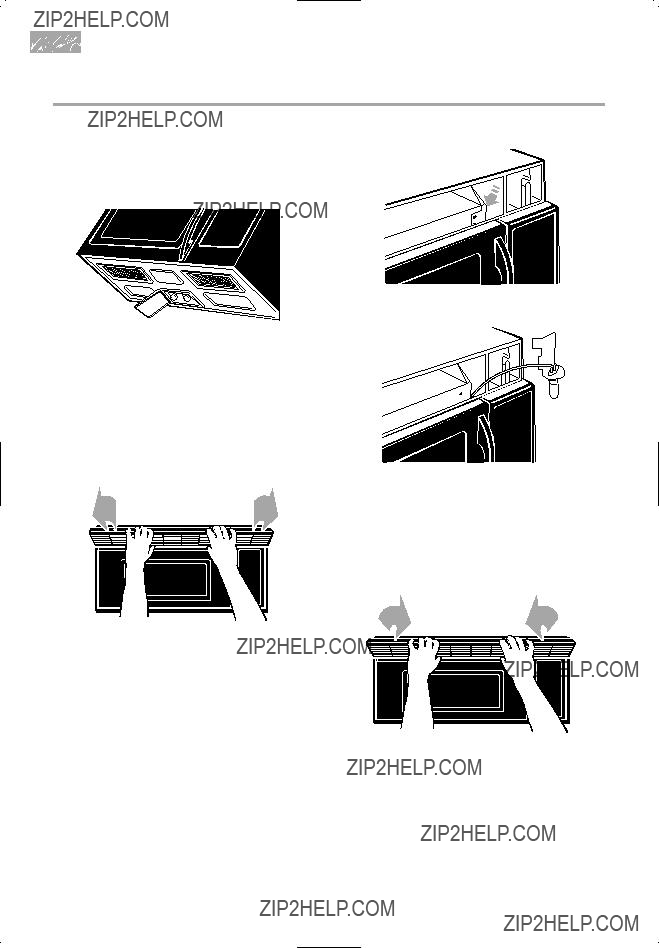
Caring for your
Replacing the cooktop and oven lights
The cooktop light
1.Disconnect power or unplug microwave oven.
2.Remove the bulb cover mounting screws.
3.We recommend replacing bulb(s) with
The oven light
1.Disconnect power or unplug microwave oven.
2.Remove the vent cover mounting screws.
3.Tip the cover forward, then lift out to remove.
4. Remove bulb holder mounting screw.
5.Lift up the bulb holder.
6.We recommend replacing the bulb with a
7.Replace the bulb holder and mounting screw.
8.Slide the top of the vent cover into place. Push the bottom until it snaps into place. Replace the mounting screws.
9.Reconnect power or plug in microwave oven.
62

Cooking Guide
Reheating chart
Times are approximate and may need to be adjusted to individual taste.
63
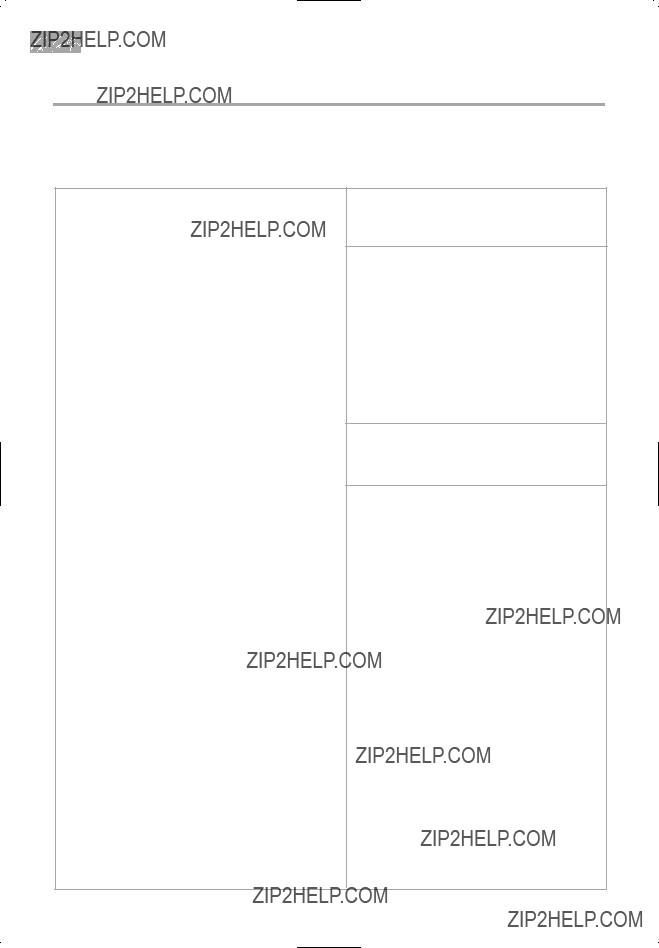
Cooking guide
Microwave cooking chart
Times are approximate and may need to be adjusted to individual taste.
NOTE: See ???Using AUTO COOK??? on page 35 for instructions on how to cook without entering cooking times or Cook Powers.
MEATS, POULTRY, FISH, SEAFOOD
Allow standing time after cooking.
Internal temperature should be 185??F (85??C) after standing.
Internal temperature should be 185??F (85??C) after standing.
VEGETABLES (continued)
Cook at 100% Cook Power.
64

Cooking guide
Microwave cooking tips
Amount of food
???The more food you prepare, the longer it takes. A rule of thumb is that a double amount of food requires almost double the time. If one potato takes 4 minutes to cook, you need about 7 minutes to cook two potatoes.
???If you want to cook two meals or containers of food at the same time, you can do so with the Metal Rack. For example, you can cook two frozen dinners or reheat two plates of food by placing one on the rack and one under the rack.
Starting temperature of food
???The lower the temperature of the food being put into the microwave oven, the longer it takes to cook. Food at room temperature will be reheated more quickly than food at refrigerator temperature.
Covering food
Cover food to:
???Reduce splattering
???Shorten cooking times
???Retain food moisture
All coverings that allow microwaves to pass through are suitable.
Releasing pressure in foods
???Several foods (for example: baked potatoes, sausages, egg yolks, and some fruits) are tightly covered by a skin or mem- brane. This can cause the food to burst from steam building up in them
during cooking. To relieve the pressure and to prevent bursting, prick these foods before cooking with a fork, cocktail pick, or toothpick.
Using standing time
Composition of food
???Food with a lot of fat and sugar will be heated faster than food containing a lot of water. Fat and sugar will also reach a higher temperature than water in the cooking process.
???The more dense the food, the longer it takes to heat. ???Very dense??? food like meat takes longer to reheat than lighter, more porous food like sponge cakes.
Size and shape
???Smaller pieces of food will cook faster than larger pieces and
???With unevenly shaped foods, the thinner parts will cook faster than the thicker areas. Place the thinner parts of chicken wings and legs in the center of the dish.
???Always allow food to stand for a while after cooking. Standing time after defrosting, cooking, or reheating always improves the result since the temperature will then be evenly distributed throughout the food.
???When cooking in a microwave oven, food continues to cook even when the microwave energy is turned off. Food is no longer cooked by microwaves, but it is still being cooked by the high heat left over from the microwave oven.
???The length of the standing time depends on the volume and density of the food. Sometimes it can be as short as the time it takes you to remove the food from the oven and take it to the serving table. However, with larger, denser food, the standing time may be as long as 10 minutes.
Stirring, turning foods
???Stirring and turning foods distributes heat quickly to the center of the dish and avoids overcooking at the outer edges of the food.
65

Cooking guide
Arranging food
For best results, distribute food evenly on the plate. You can do this in several ways:
???If you are cooking several items of the same food, such as baked potatoes, place them in a ring pattern for uniform cooking.
???When cooking foods of uneven shapes or thickness, such as chicken breasts, place the smaller or thinner area of the food towards the center of the dish where it will be heated last.
???Layer thin slices of meat on top of each other.
???When you cook or reheat whole fish, score the skin ??? this prevents cracking. Shield the tail and head of whole fish with small pieces of foil to prevent overcooking and ensure the foil does not touch the sides of the oven.
???Do not let food or container touch the top or sides of the oven. This will prevent possible arcing.
Using aluminum foil
Metal containers usually should not be used in a microwave oven. There are, however, some exceptions. If you have purchased food which is prepackaged in an aluminum foil container, then refer to the instructions on the package. When using aluminum foil containers, cooking times may be longer because microwaves will only penetrate the top of the food.
If you use aluminum containers without pack- age instructions, follow these
guidelines:
???Place container in a glass bowl and add some water so that it covers the bottom
of the container, not more than 1???4 inch high. This ensures even heating of the container bottom.
???Always remove the lid to avoid damage to the oven.
???Use only undamaged containers.
???Do not use containers taller than 3???4 inch.
???Container must be half filled.
???To avoid sparking, there must be a minimum 1???4 inch (.6 cm) between the aluminum container and the walls of the oven and also between two aluminum containers.
???Reheating food in aluminum foil containers usually takes up to double the time compared to reheating in plastic, glass, china, or paper containers. The time when food is ready will vary a great deal.
???Let food stand for 2 to 3 minutes after heating so that heat is spread evenly throughout container.
Cooking you should not do in your microwave oven
???Do not do canning of foods in the oven. Closed glass jars may explode, resulting in damage to the oven.
???Do not use the microwave oven to sterilize objects (baby bottles, etc.). It is dif- ficult to maintain the high temperature required for safe sterilization.
66

Cooking guide
Oven cookware guide
You can use a variety of cookware and materials in your
YES: Cookware to use
NO: Cookware to avoid
*Refer to ???Microwave cooking tips??? on page 65 and ???Questions and Answers??? on page 68 for proper use.
67
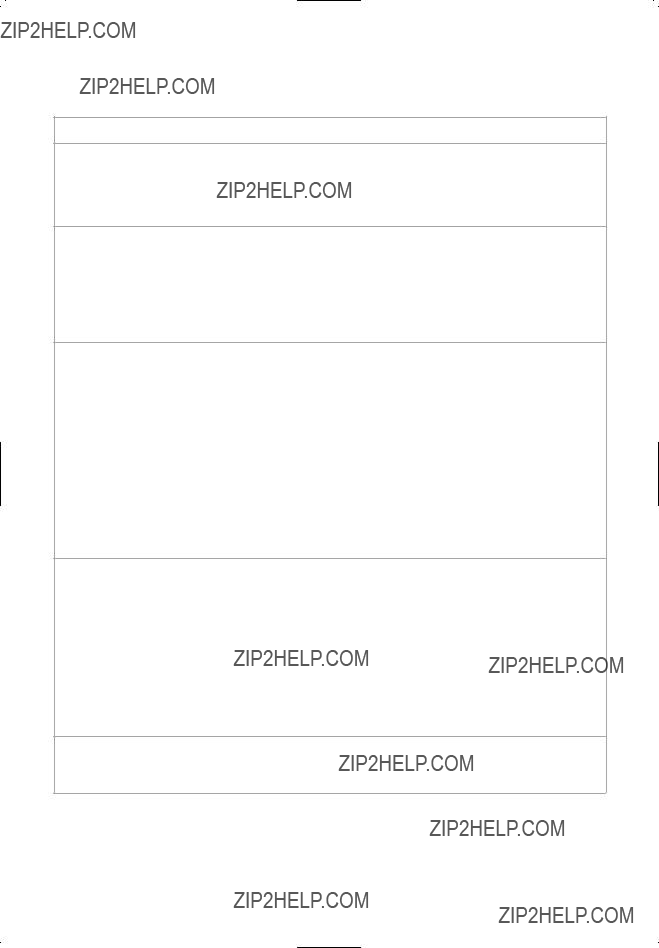
Questions and Answers
Can I use a rack in my microwave oven so that I may reheat or cook on two levels at a time?
You can use a rack only if rack is supplied with your microwave oven. Use of any rack not supplied with the microwave oven can result in poor cooking performance and/or arcing.
Can I use either metal or aluminum pans in my microwave oven?
Usable metal includes aluminum foil for shielding (use small, flat pieces), small skewers, and shallow foil trays (if tray is not taller than 3???4 inch (1.9 cm) deep and filled with food to absorb microwave energy). Never allow metal to touch walls or door. (For more information, see page 65.)
Can I pop popcorn in my microwave oven? How do I get the best results?
Yes. Pop packaged microwave popcorn following manufacturer???s guidelines or use the preprogrammed Popcorn pad. Do not use regular paper bags. Use the ???listening test??? by stopping the oven as soon as
the popping slows to a ???pop??? every 1 or 2 seconds. Do not repop unpopped kernels. You can also use special micro- wave poppers. When using a popper, be sure to follow manufacturer???s directions. Do not pop popcorn in glass cookware.
Why does steam come out of the air exhaust vent?
Steam is normally produced during cooking. The microwave oven has been designed to vent this steam out the top vent.
68

Troubleshooting
This section is designed to help you save the cost of a service call. It outlines possible problems, their causes, and actions you can take to solve each problem. If you still need assistance or service, call our Consumer Assistance Centre, see page 71, for help or calling for service. Please provide a detailed description of the problem, your appliance's complete model and serial numbers, and the purchase or installation date. (See the ???A Note to You??? section.) This information will help us respond properly to your request.
The door is not firmly closed and latched.
Firmly close and latch door.
You did not touch START. You did not follow directions exactly.
An operation that was programmed earlier is still run- ning.
Touch START.
Check instructions for the function you are operating.
Touch CANCEL/OFF to cancel previ- ous programming.
69
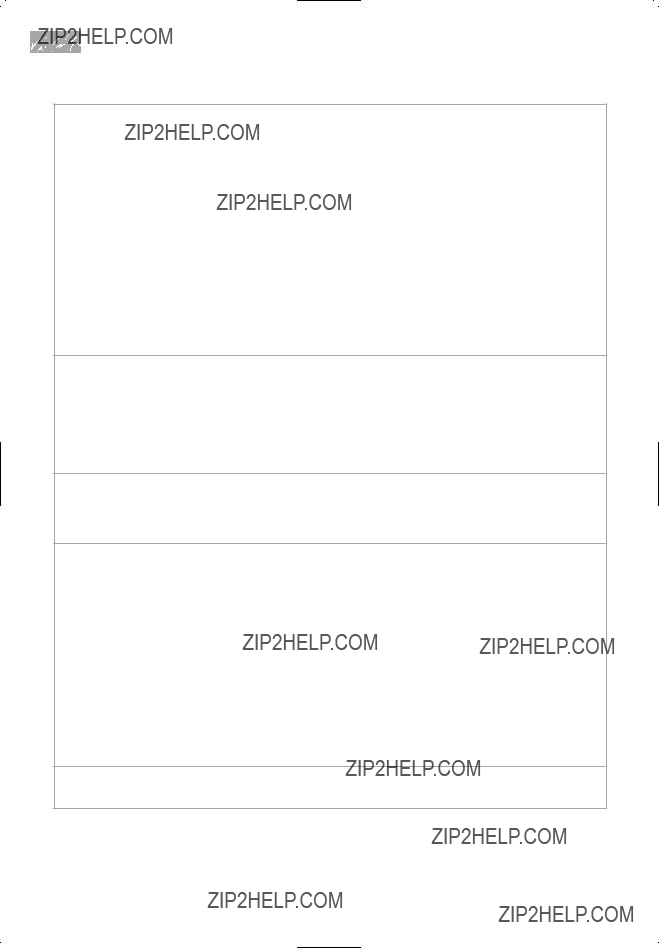
Troubleshooting
Foods undercook during convec- tion and combination cooking
You have not followed the recipe closely enough.
Foods are not prepared and ready to place in the oven. This increases heat loss from the door being open.
Follow reliable recipes exactly for in- gredients, cookware, cooking time, and proper rack position.
Make sure foods are properly pre- pared and ready to place in oven.
Smoke is com- ing from back of oven during broiling
This is normal, just as in conventional broiling.
The microwave oven turns off too soon or not soon enough when using the Temperature Probe
Probe is not pushed far enough into the food. Probe is not positioned correctly in the food. When cooking roasts, you have not let roast stand after cooking.
Probe is not plugged in correctly.
Cook Power is not set correctly.
Probe temperature is not set correctly.
Insert at least 1???3 of probe into the food.
Position probe tip in the center of the food.
Allow roast to stand for a few minutes after cooking.
Plug probe tightly into its socket.
Reset the Cook Power.
Reset the probe temperature.
70
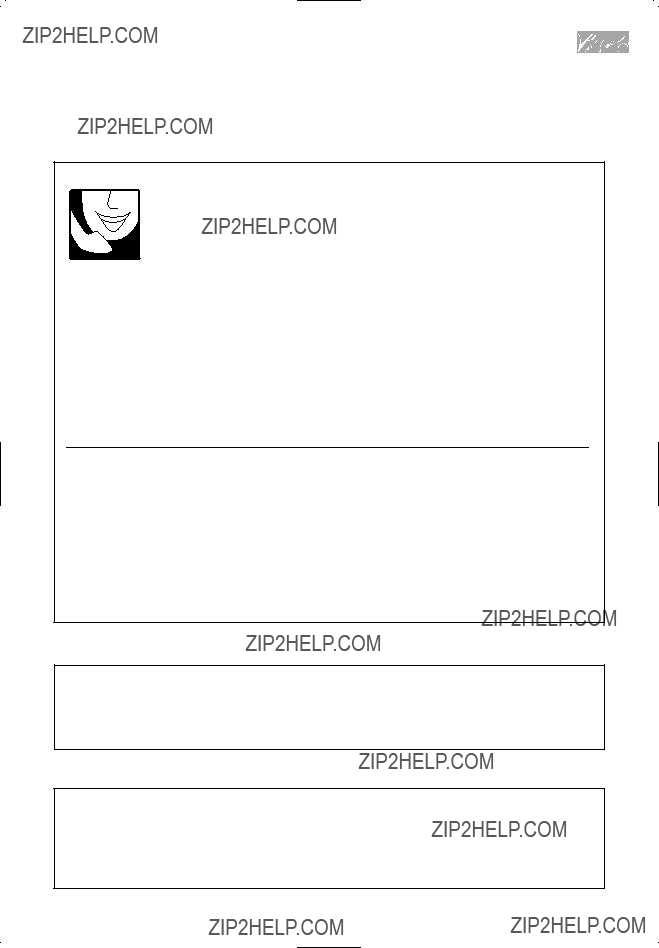
Requesting Assistance or Service
Before calling for assistance or service, please check the ???Troubleshooting Guide??? section. It may save you the cost of a service call. If you still need help, follow these instructions.
If you need assistance or service:
Call the KitchenAid Consumer Assistance Center toll free: 8:30 a.m. - 6 p.m. (EST) at
When calling:
Please know the purchase date, and the complete model and serial number of your appliance (see the ???A Note to You??? section). This information will help us to better respond to your request.
Our consultants provide assistance with:
???Features and specifications on our full line of appliances.
???Accessory and repair parts sales.
???Specialized customer assistance (French speaking, hearing impaired, limited vision, etc.).
???Referrals to local dealers, service companies, and repair parts distributors.
KitchenAid service technicians are trained to fulfill the product warranty and provide
To locate the authorized KitchenAid service company in your area, you can also look in your telephone directory Yellow Pages.
KitchenAid Canada Appliance Service ??? Consumer Services
Direct service branches:
If you need replacement parts
If you need to order replacement parts, we recommend that you only use factory authorized parts. These parts will fit right and work right, because they are made with the same precision used to build
every new KITCHENAID?? appliance. To locate factory authorized replacement parts in your area, call our Consumer Assistance Center telephone number or your nearest authorized service center.
For further assistance
If you need further assistance, you can write to KitchenAid with any questions or concerns at:
Please include a daytime phone number in your correspondence.
Consumer Relations Department
KitchenAid Canada
1901 Minnesota Court
Mississauga, Ontario L5N3A7
71

Microwave Hood
Warranty
KITCHENAID CANADA DOES NOT ASSUME ANY RESPONSIBILITY FOR INCIDENTAL OR CONSEQUENTIAL DAMAGES. Some provinces do not allow the exclusion or limitation of incidental or consequential damages, so this exclusion or limitation may not apply to you. This warranty gives specific legal rights and you may also have other rights which vary from province to province.
If you need assistance or service, first see the ???Troubleshooting??? section of this book. After checking ???Troubleshooting,??? additional help can be found by checking the ???Requesting Assis- tance or Service??? section. Call KitchenAid Canada at one of the telephone numbers listed in the ???Requesting Assistance or Service??? section.